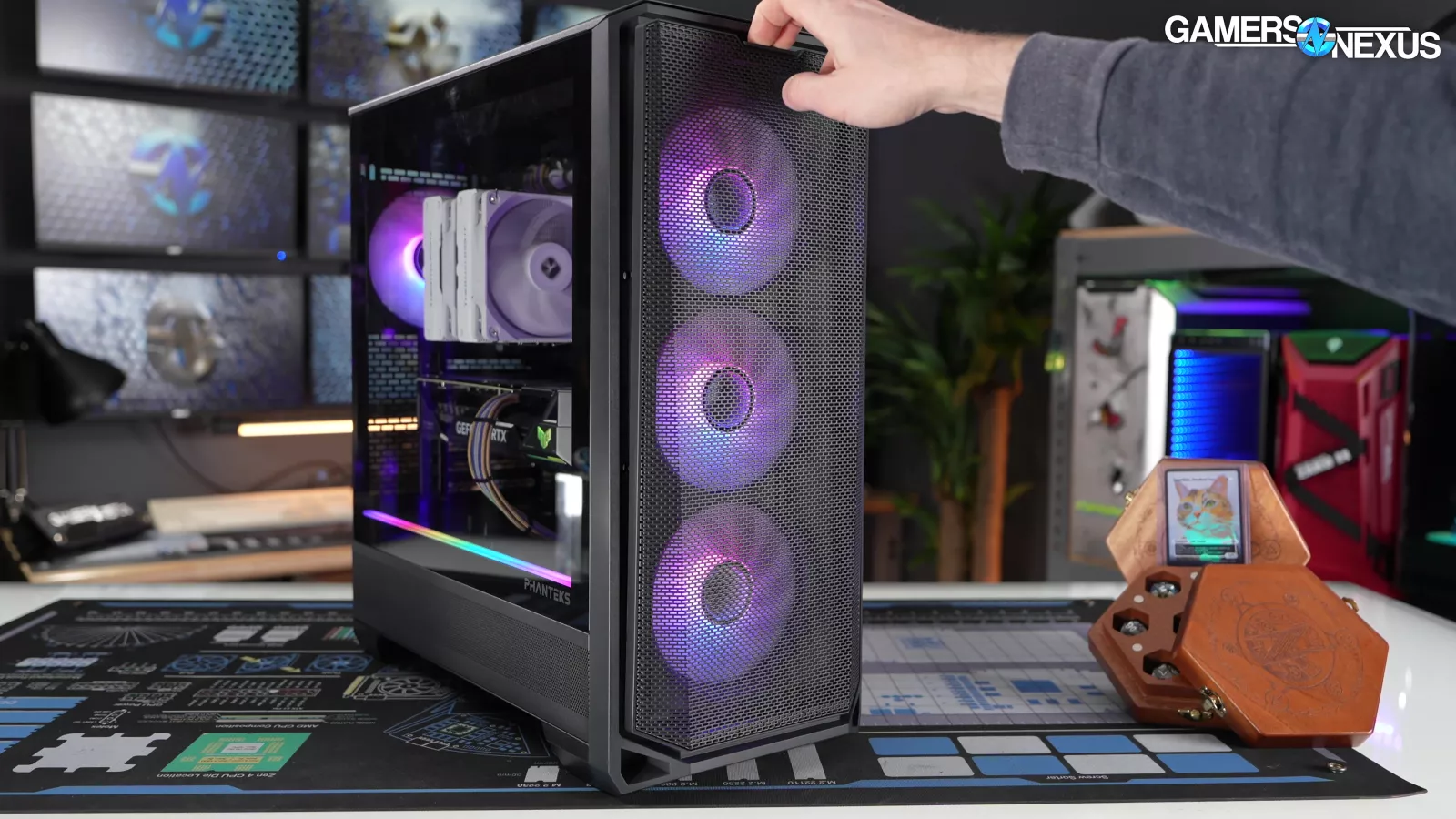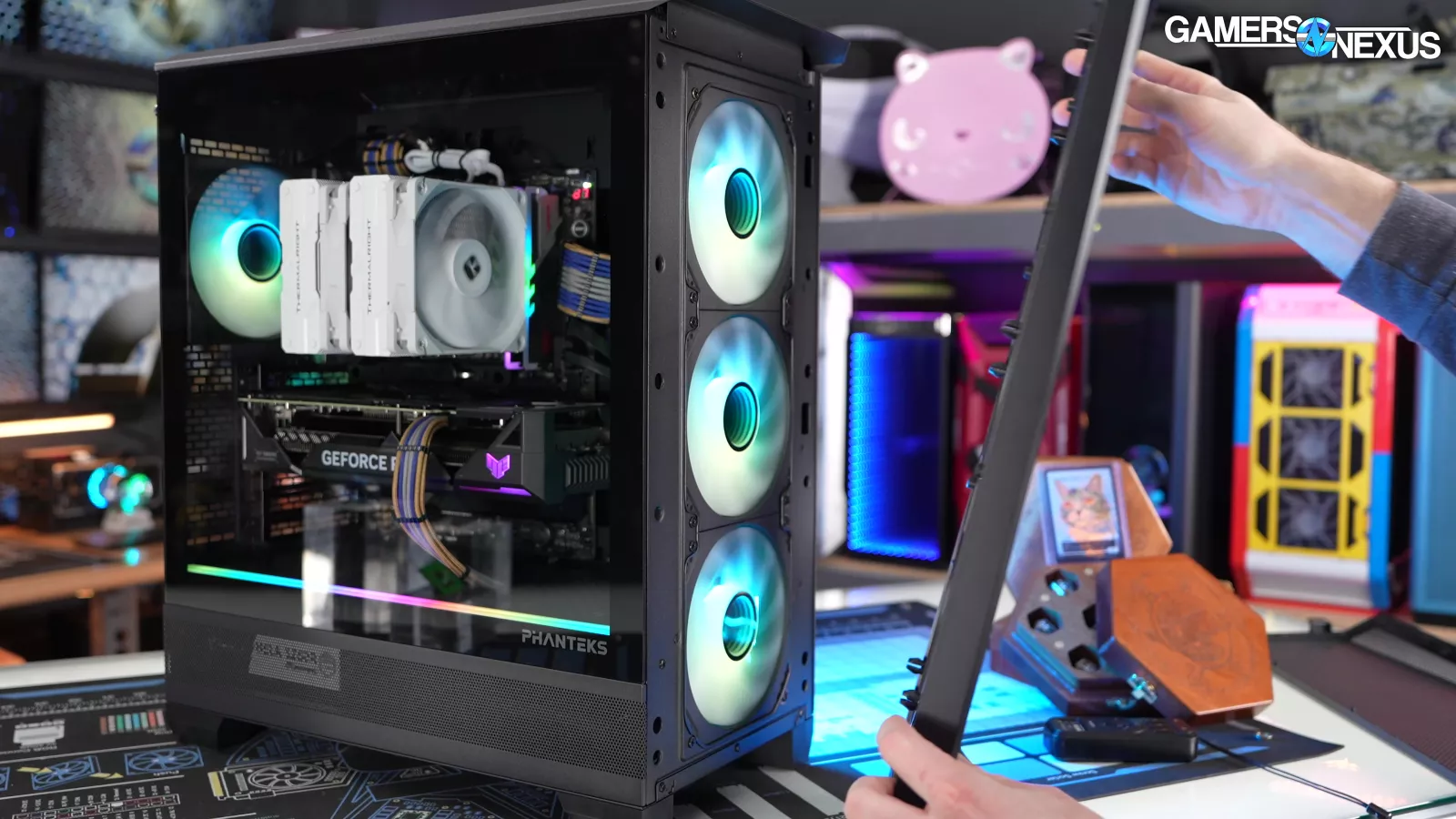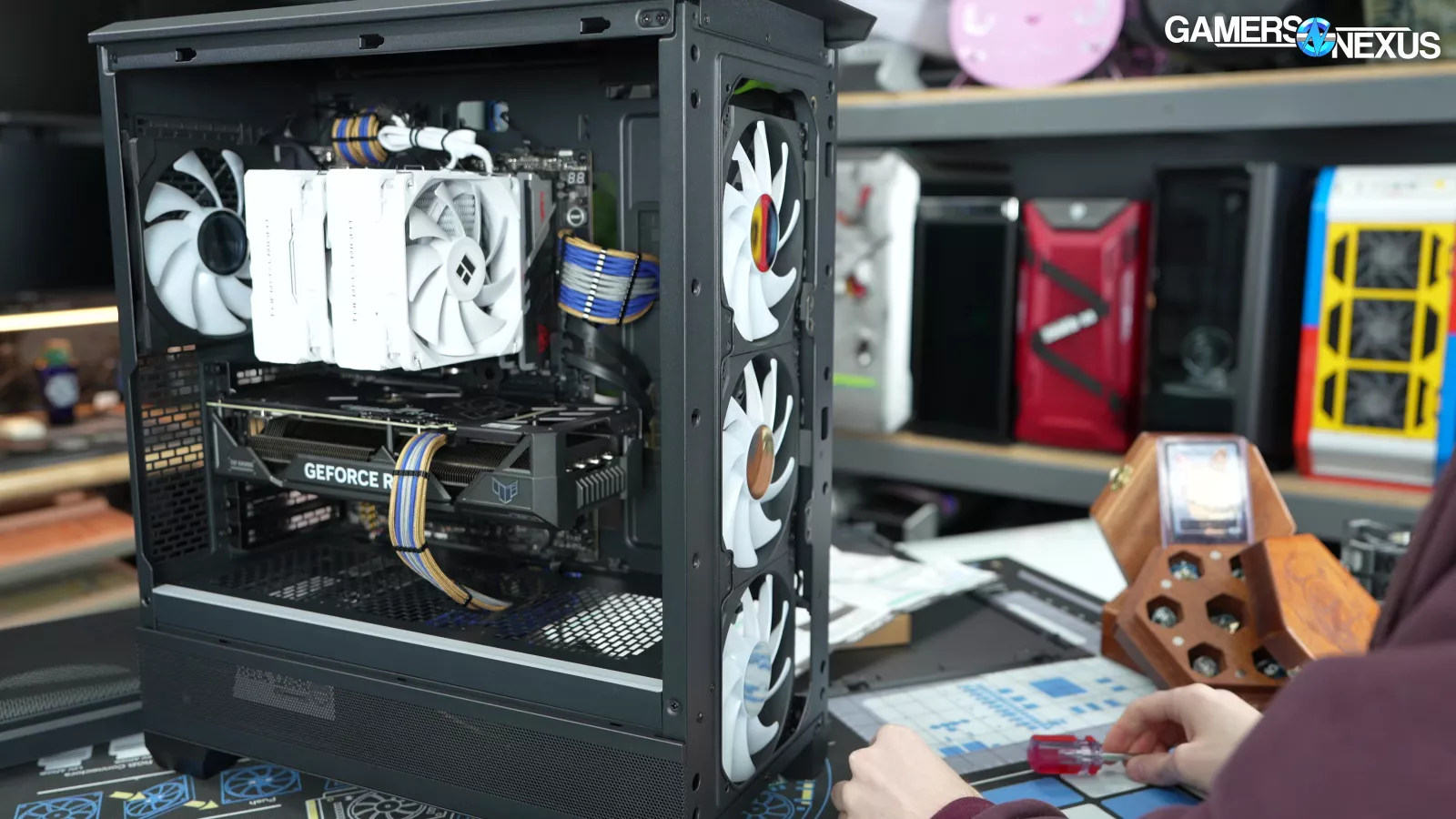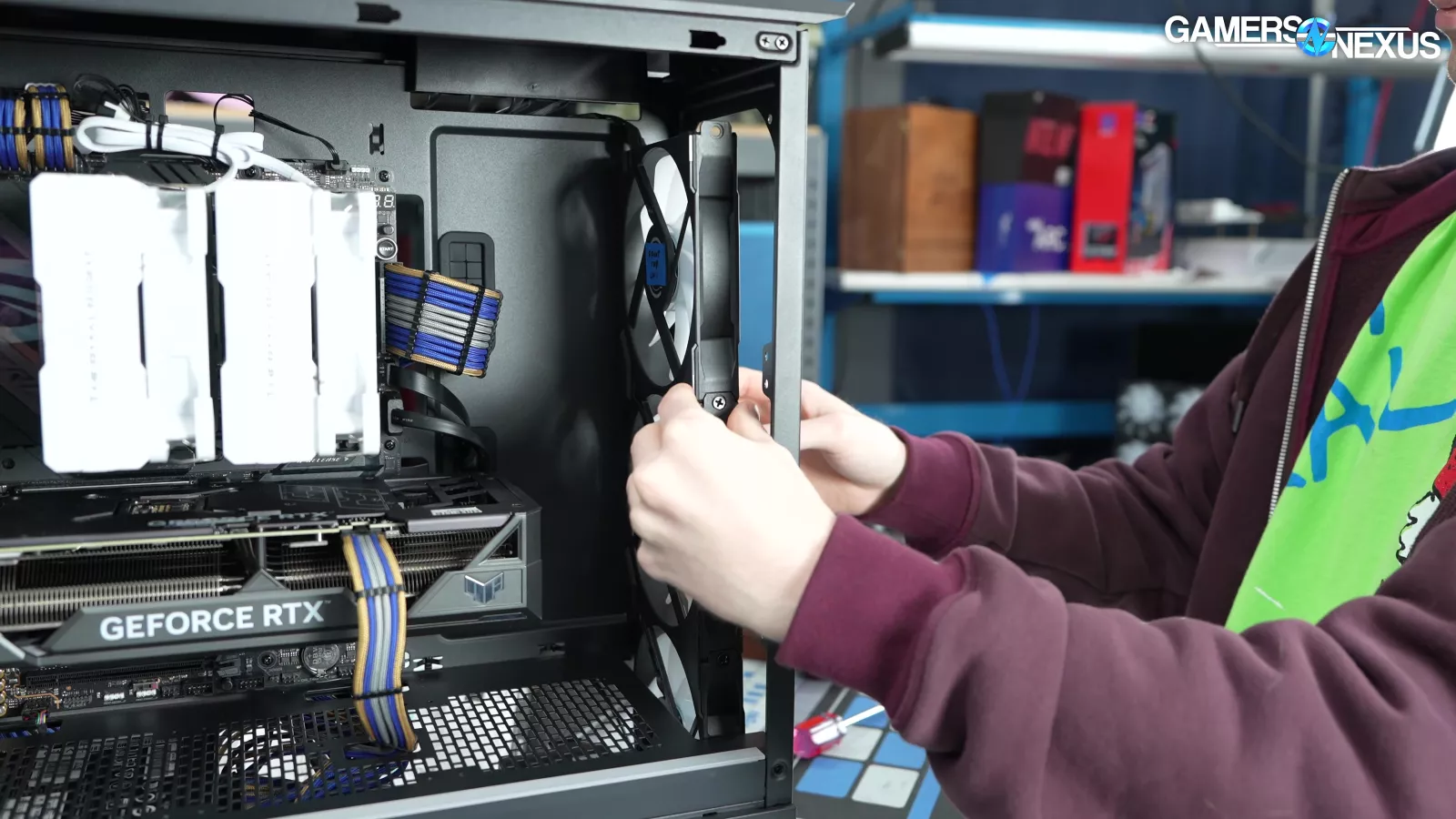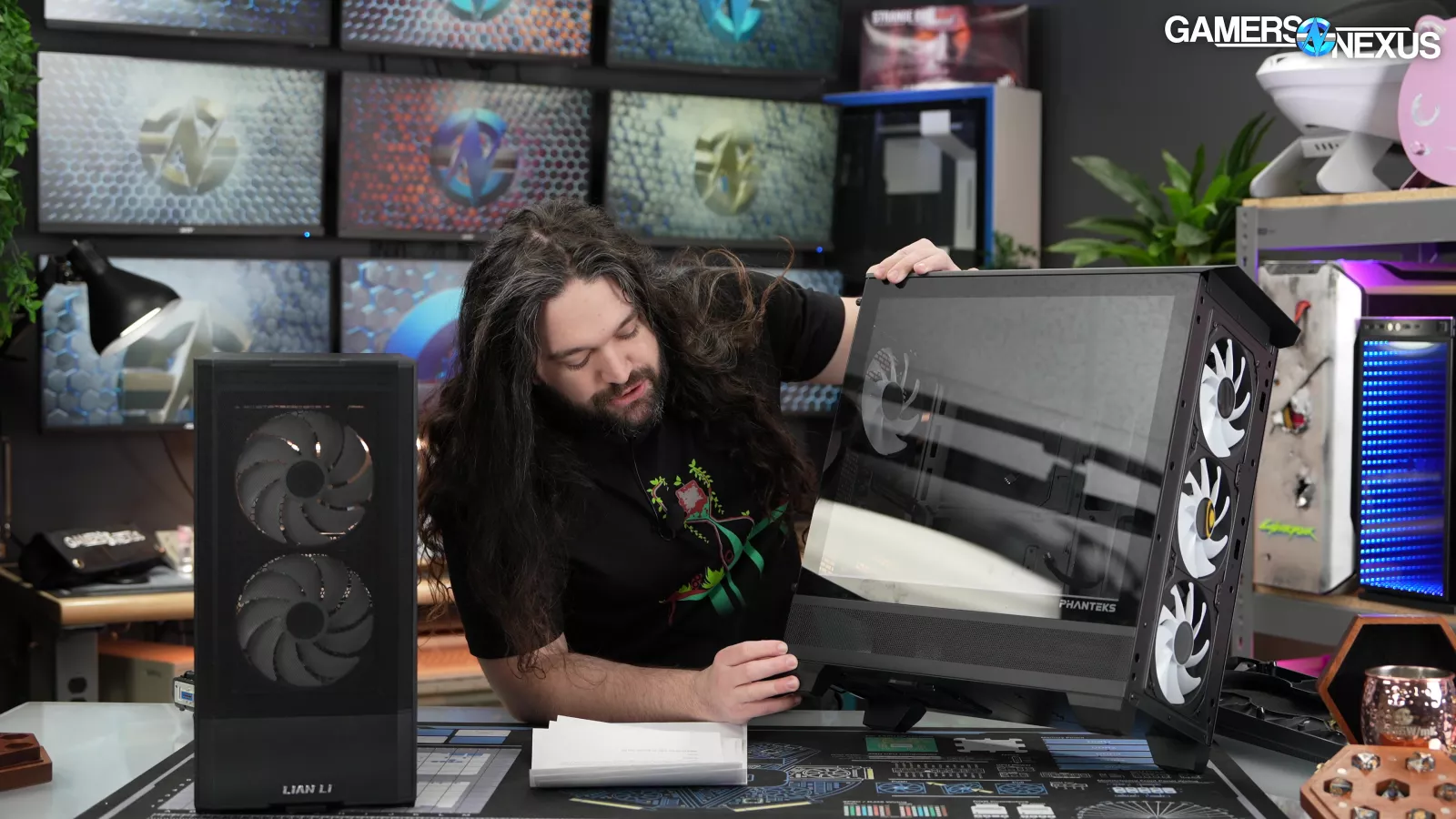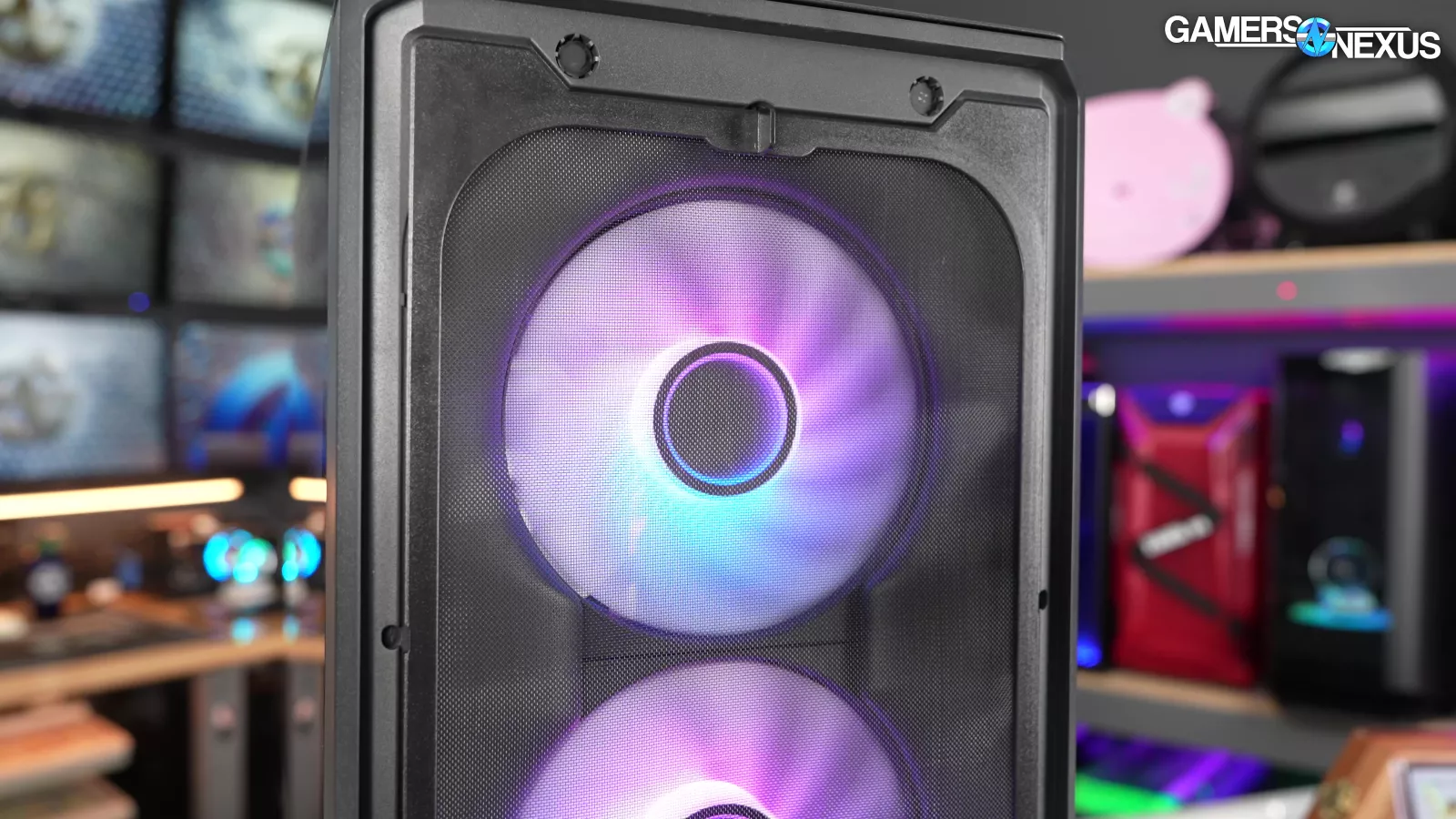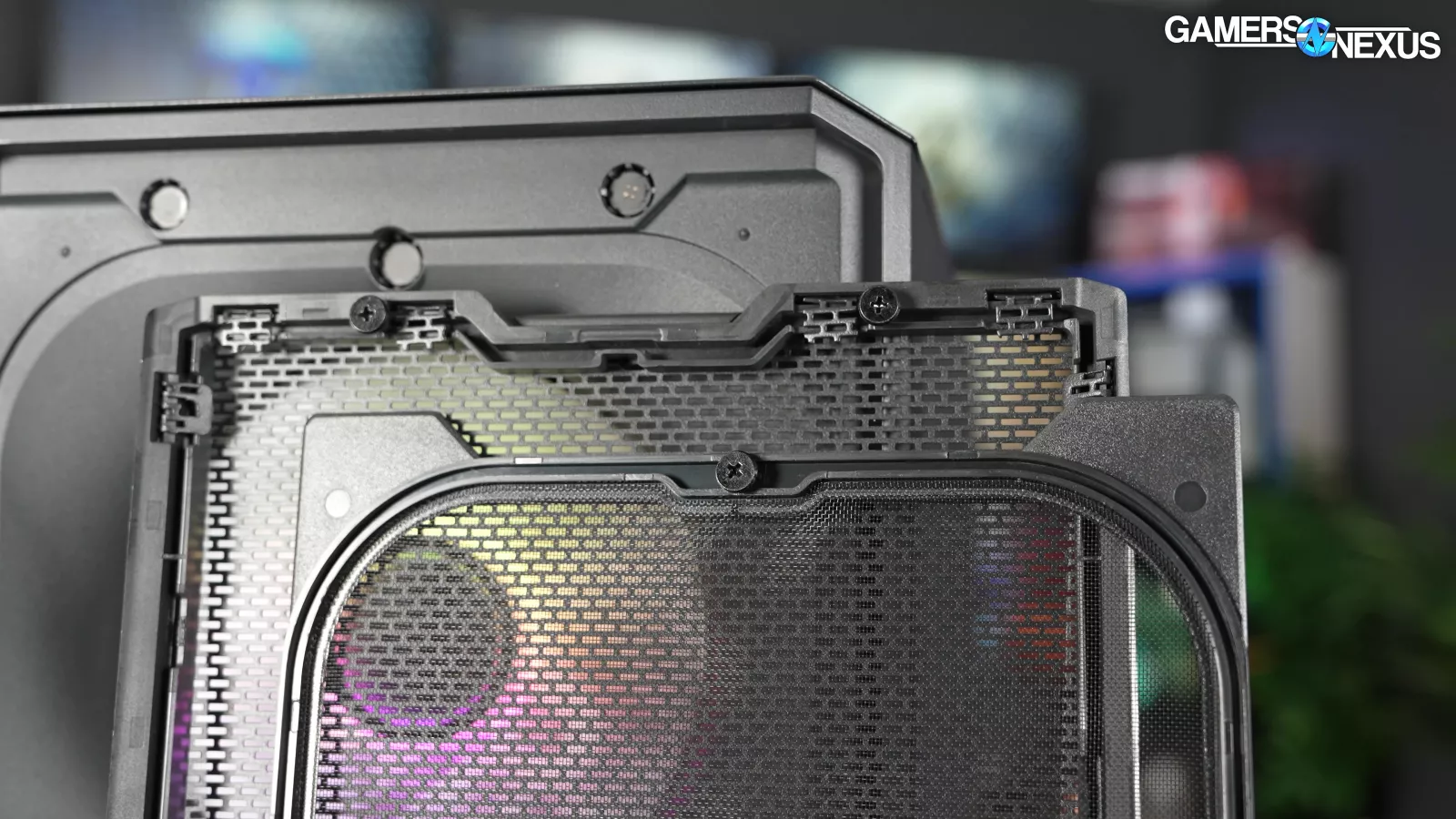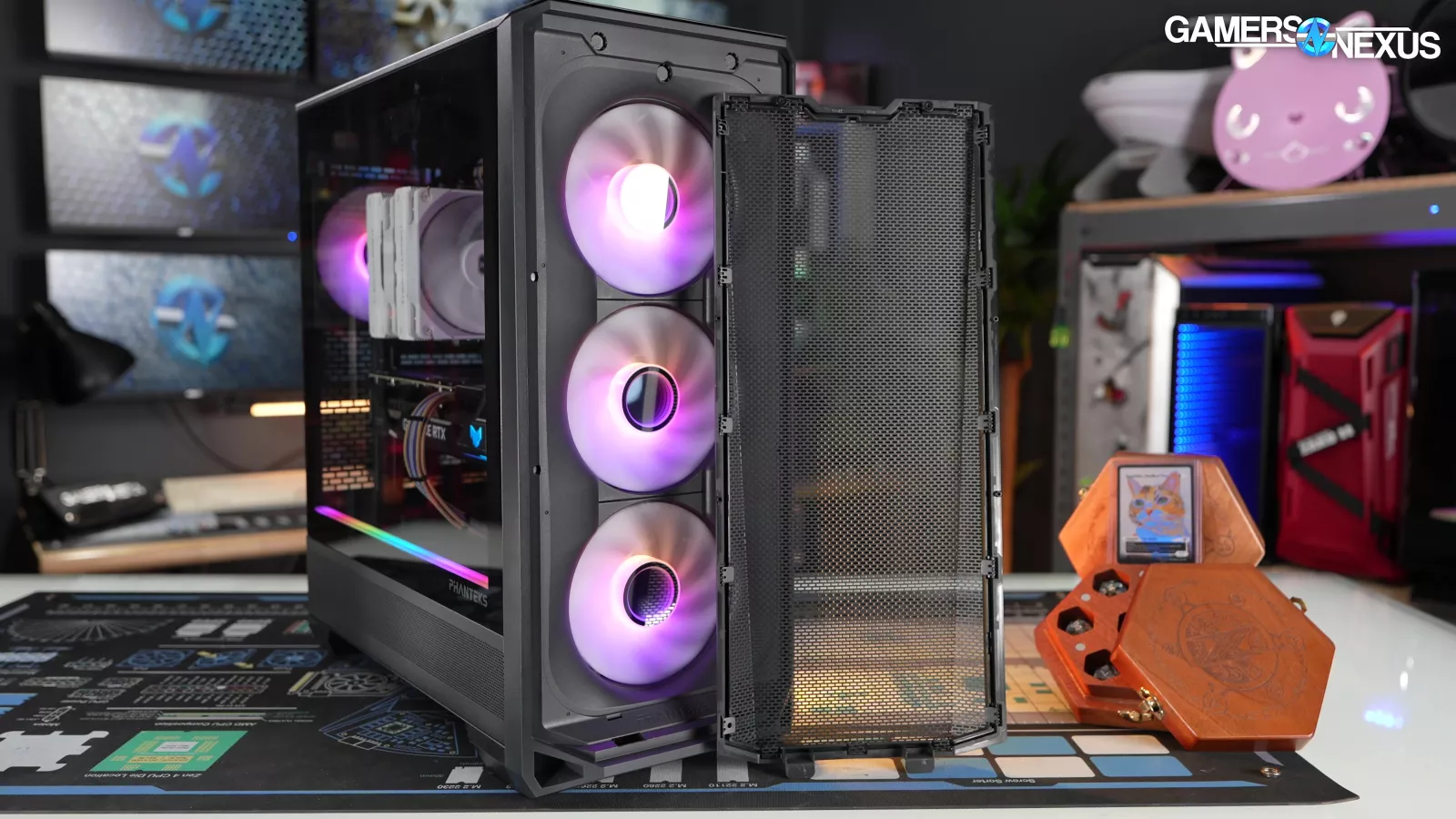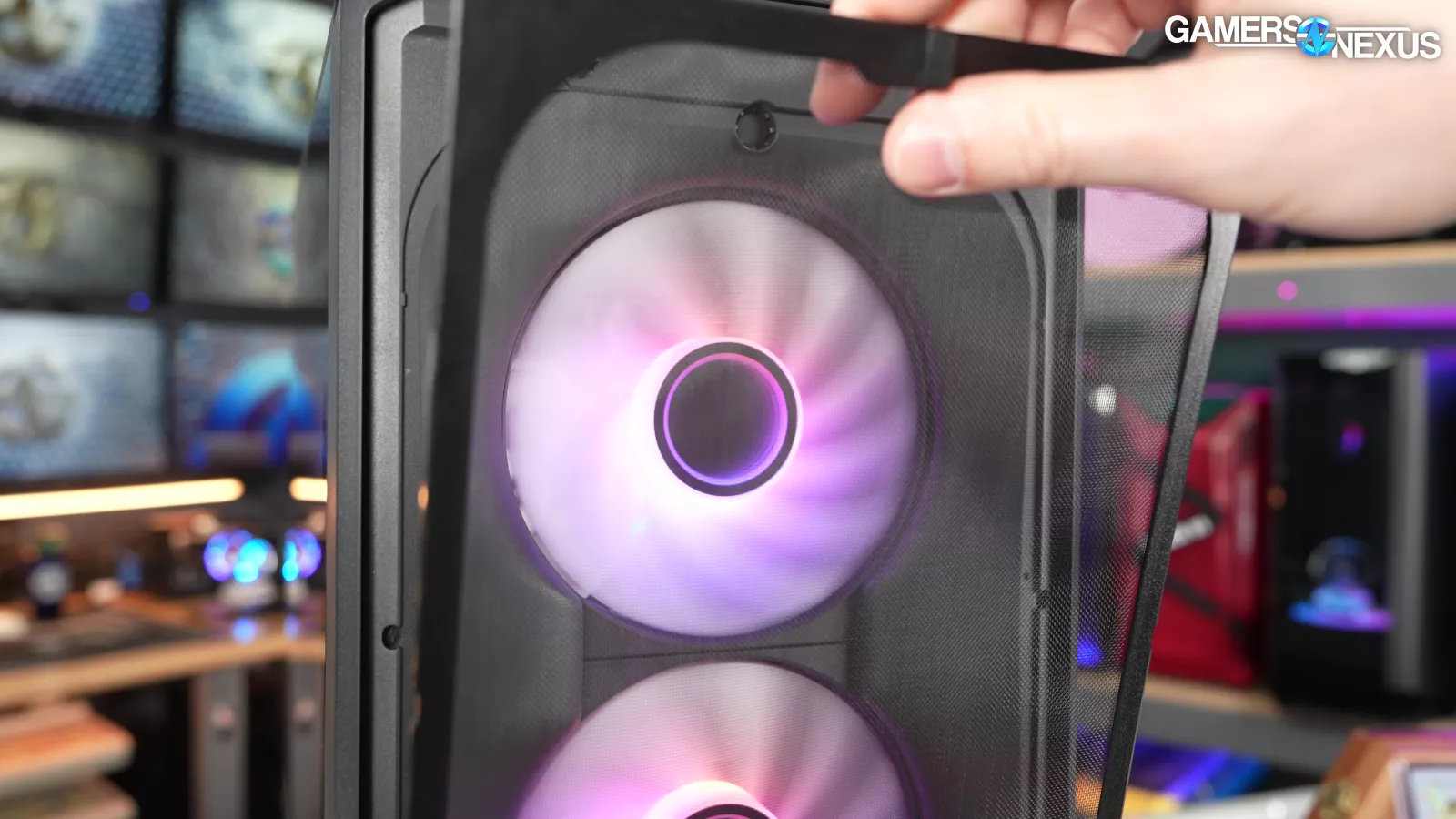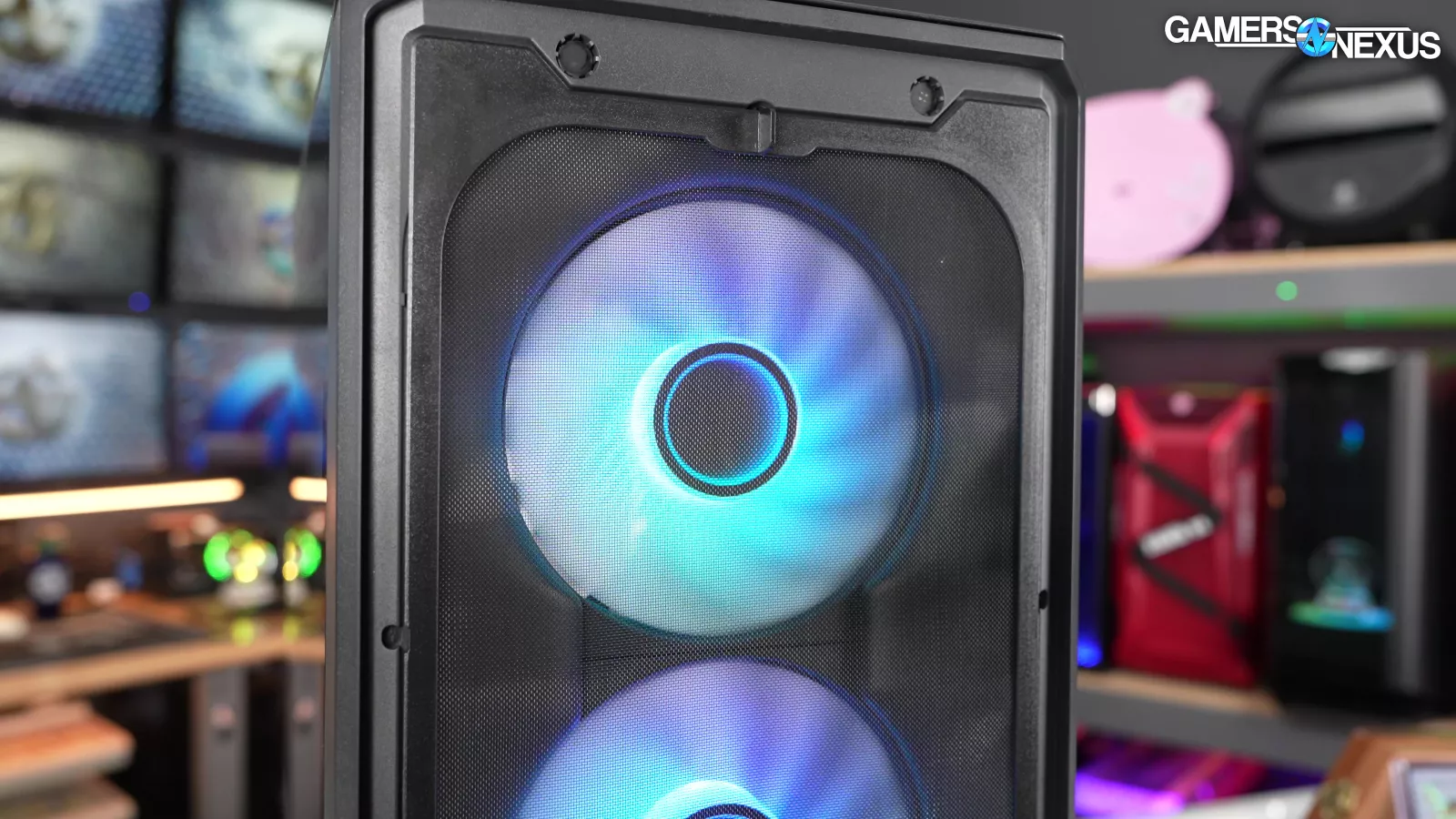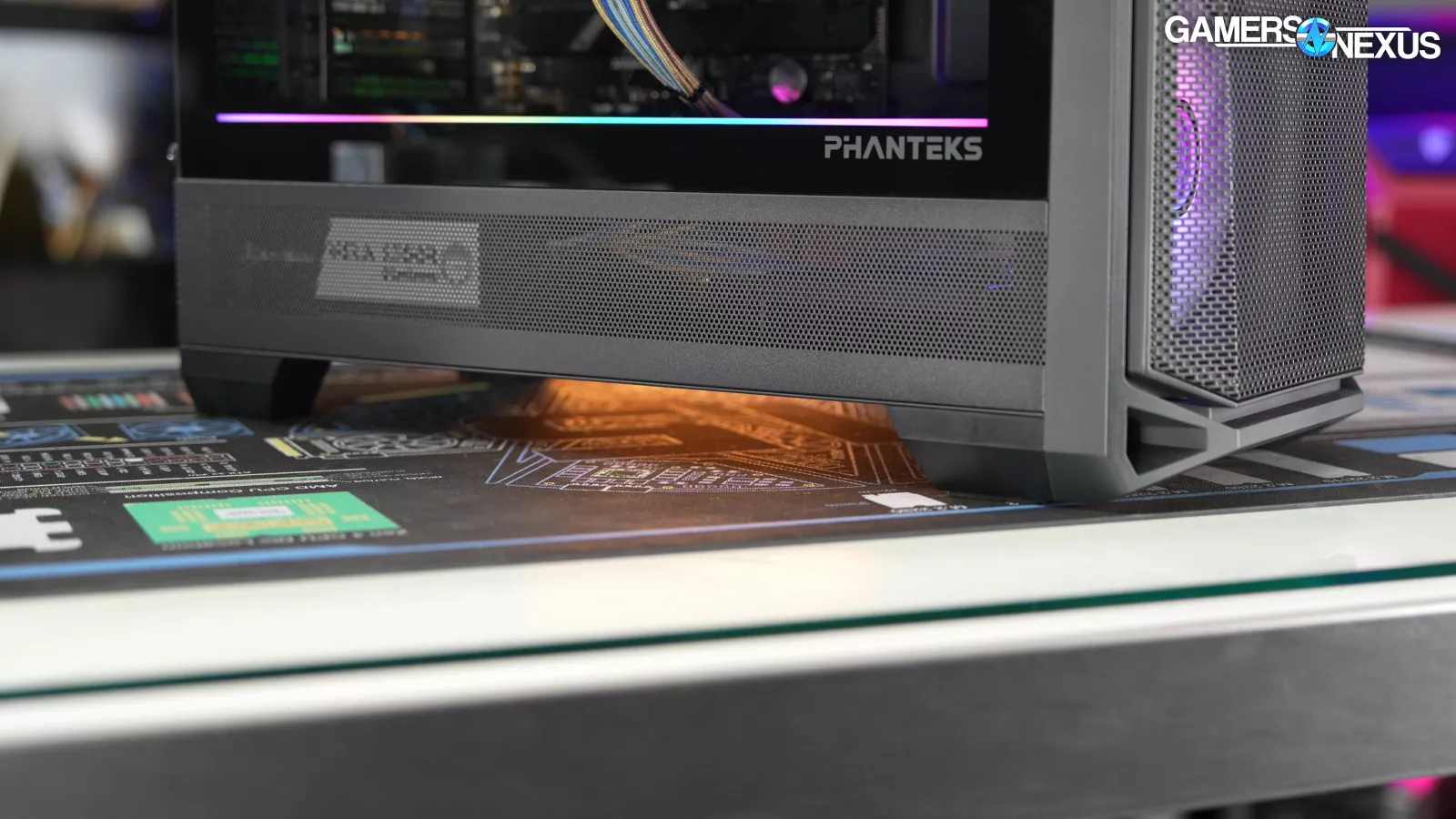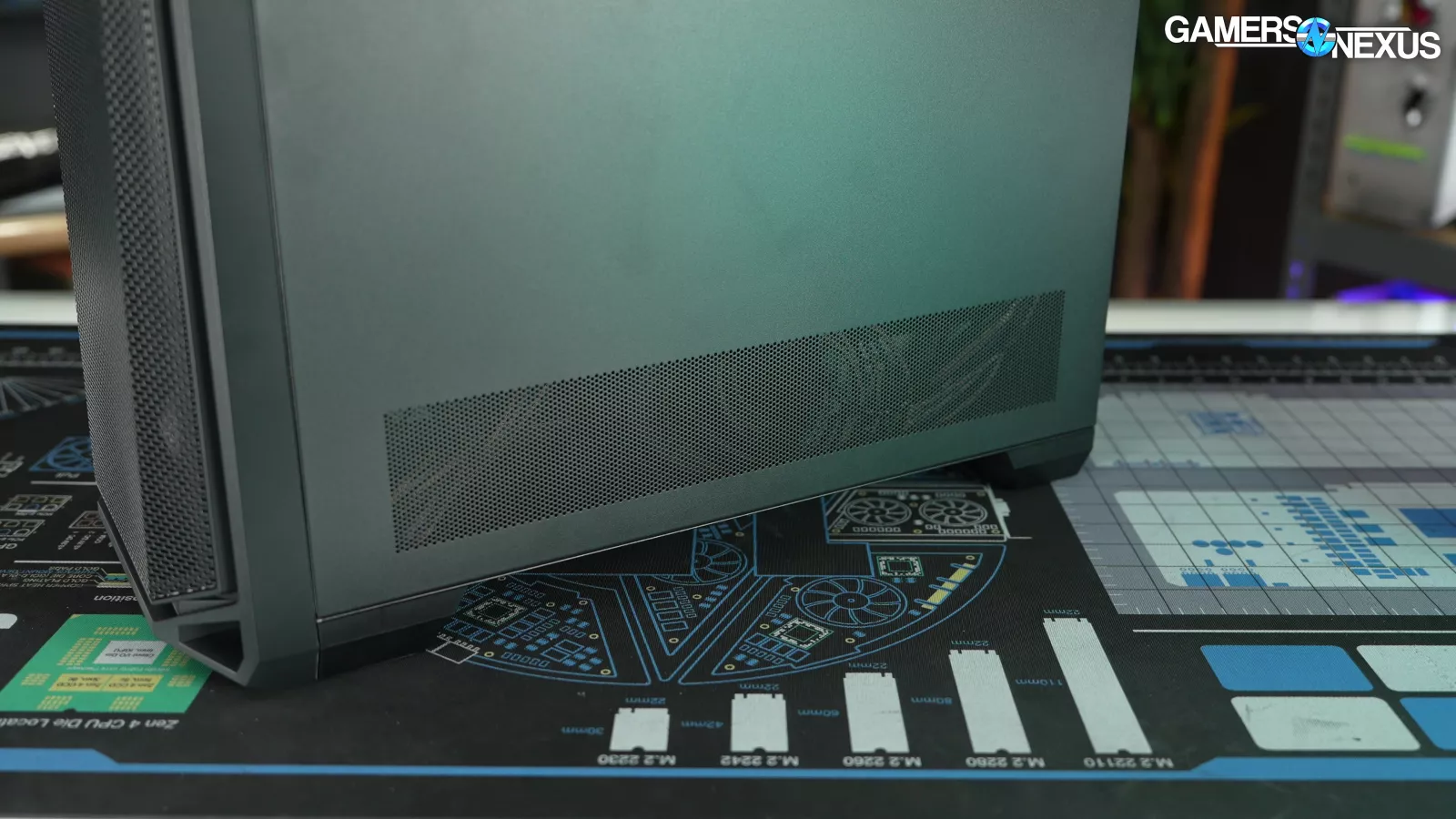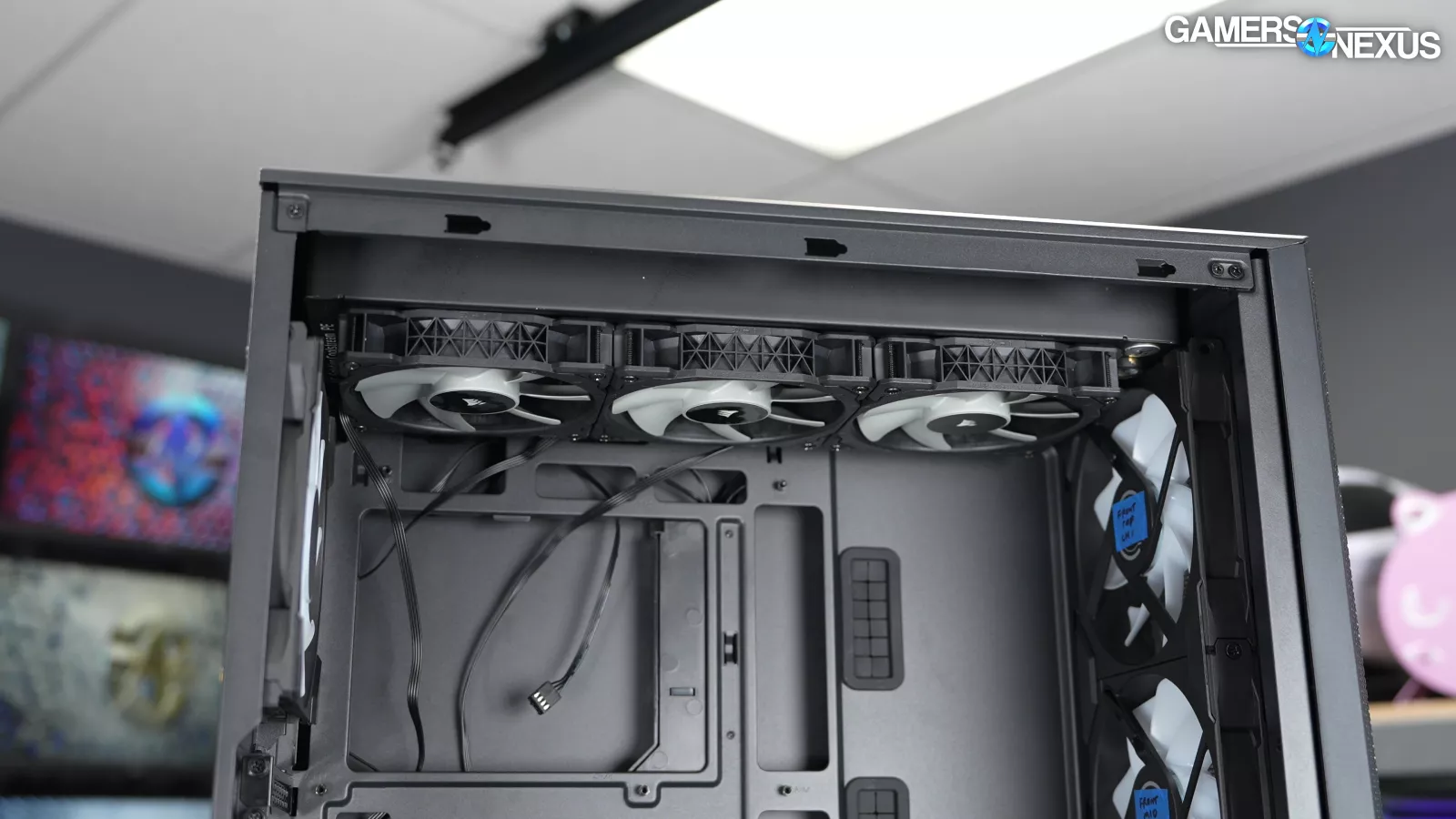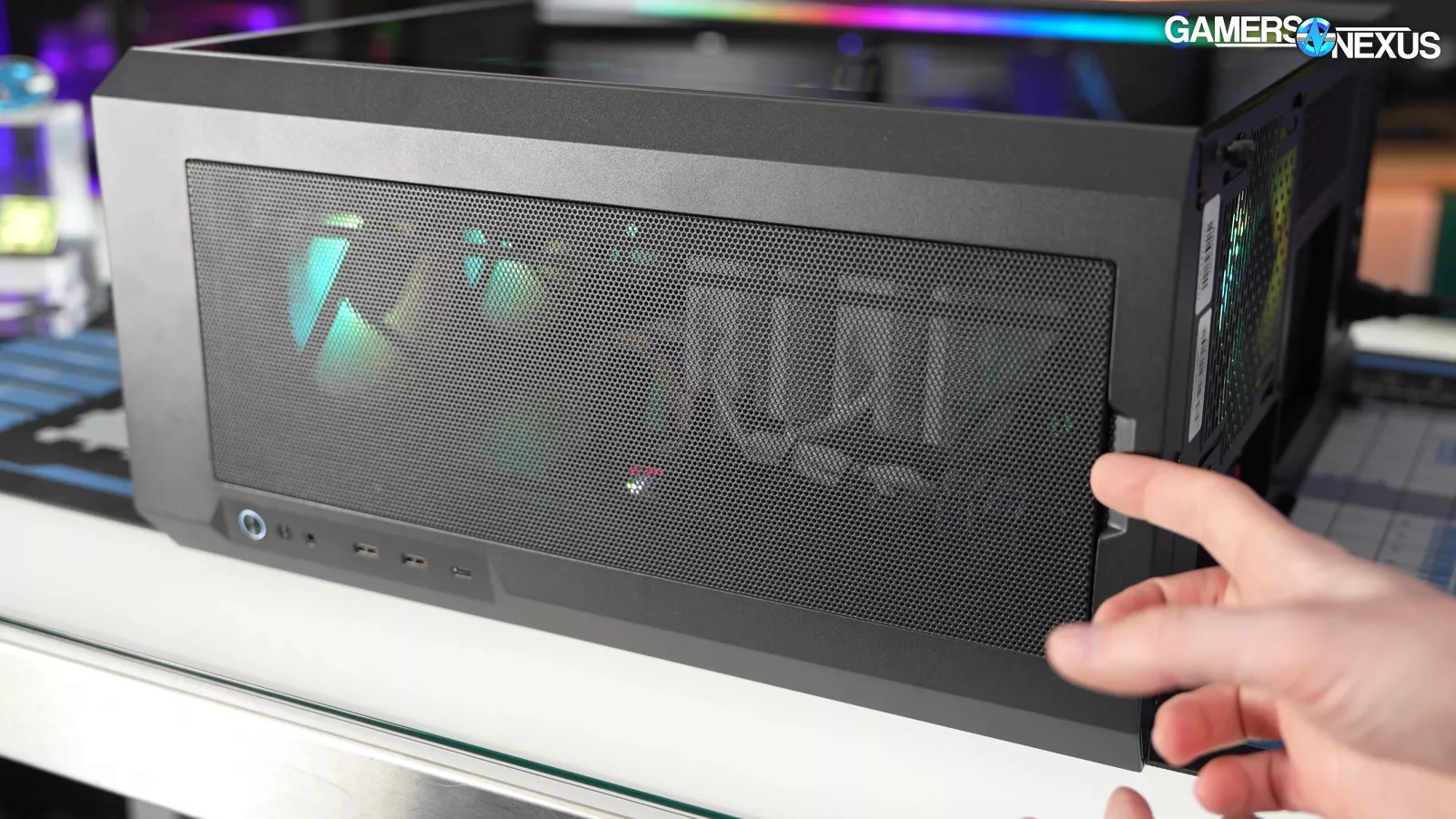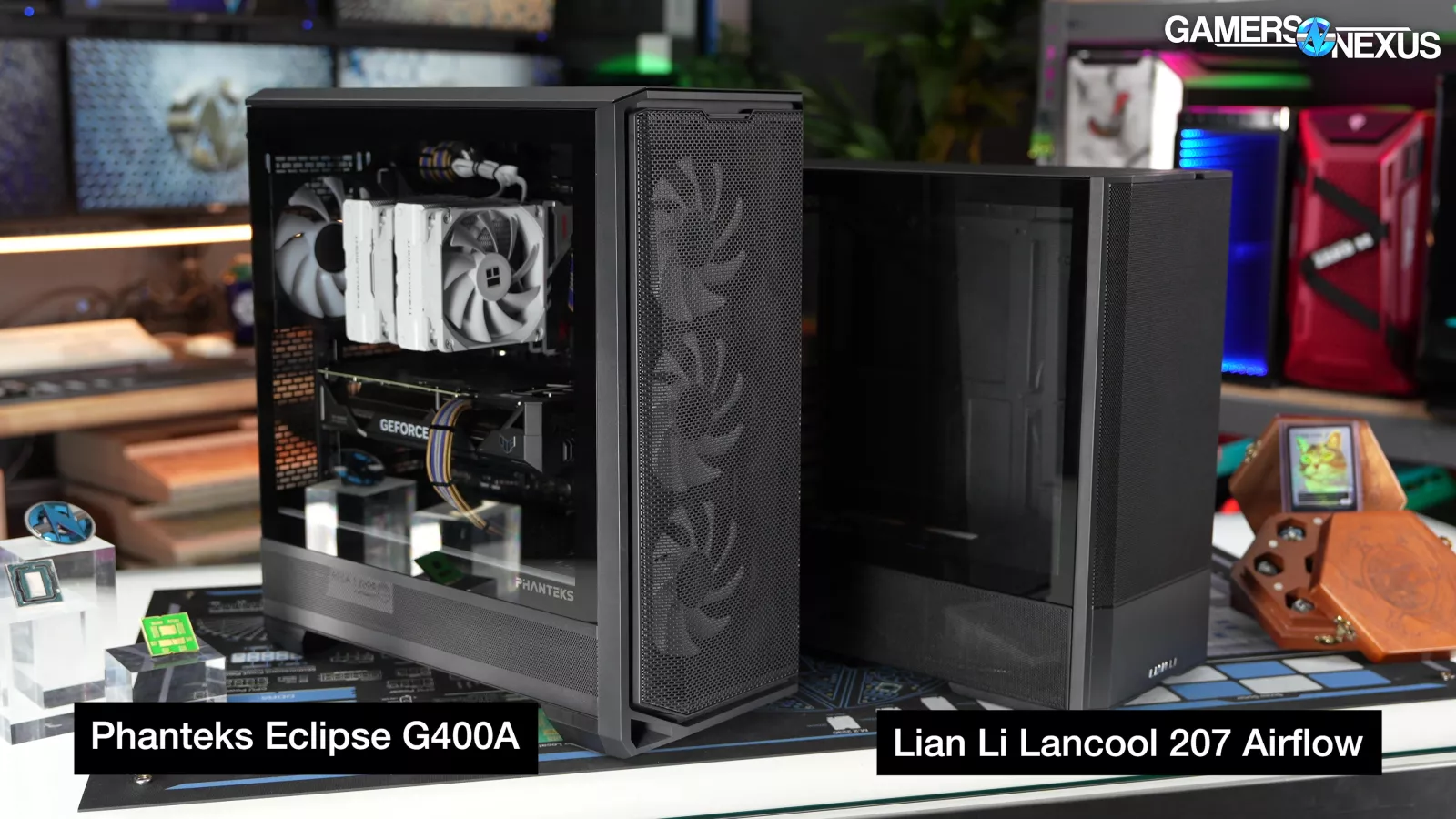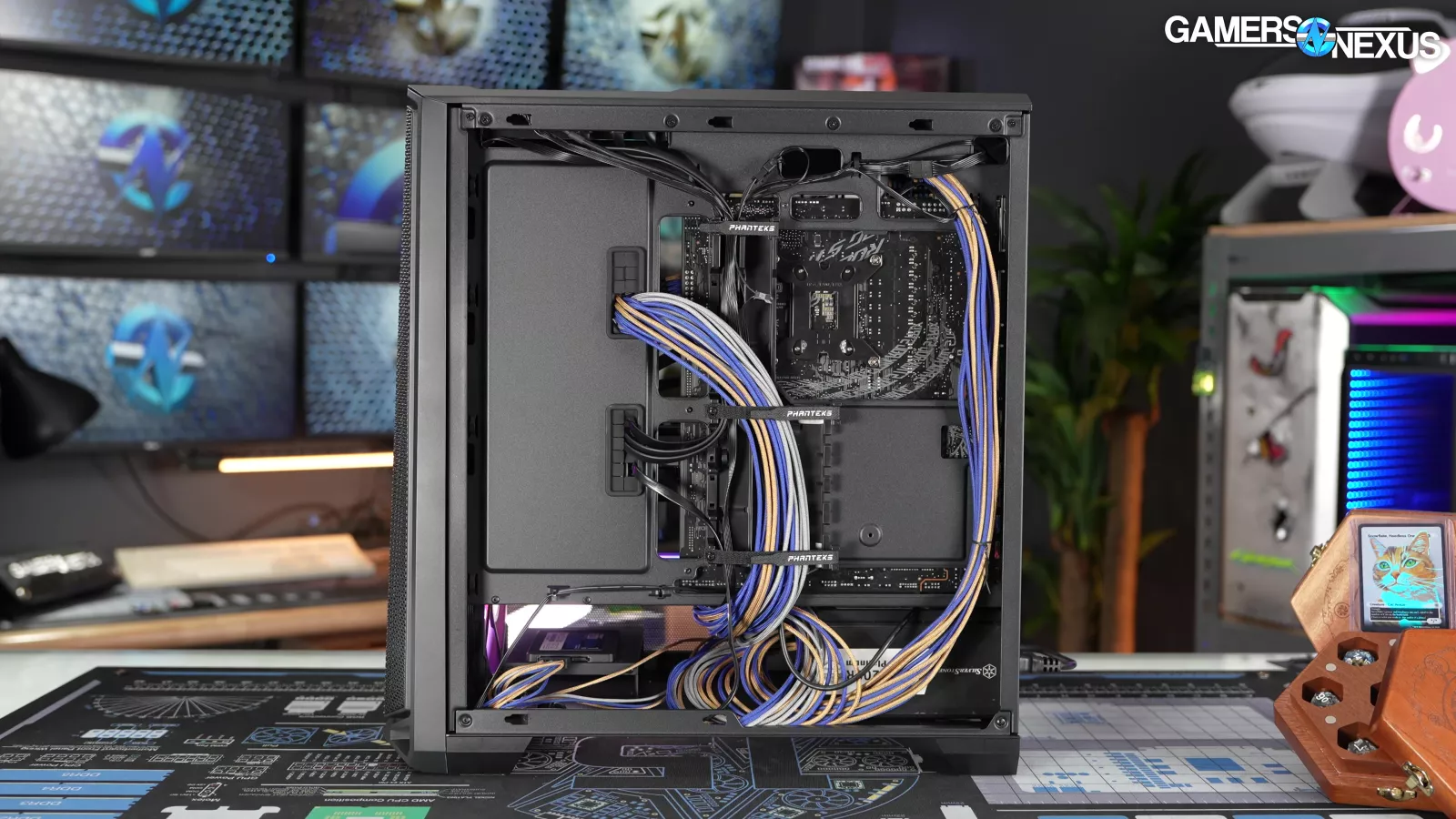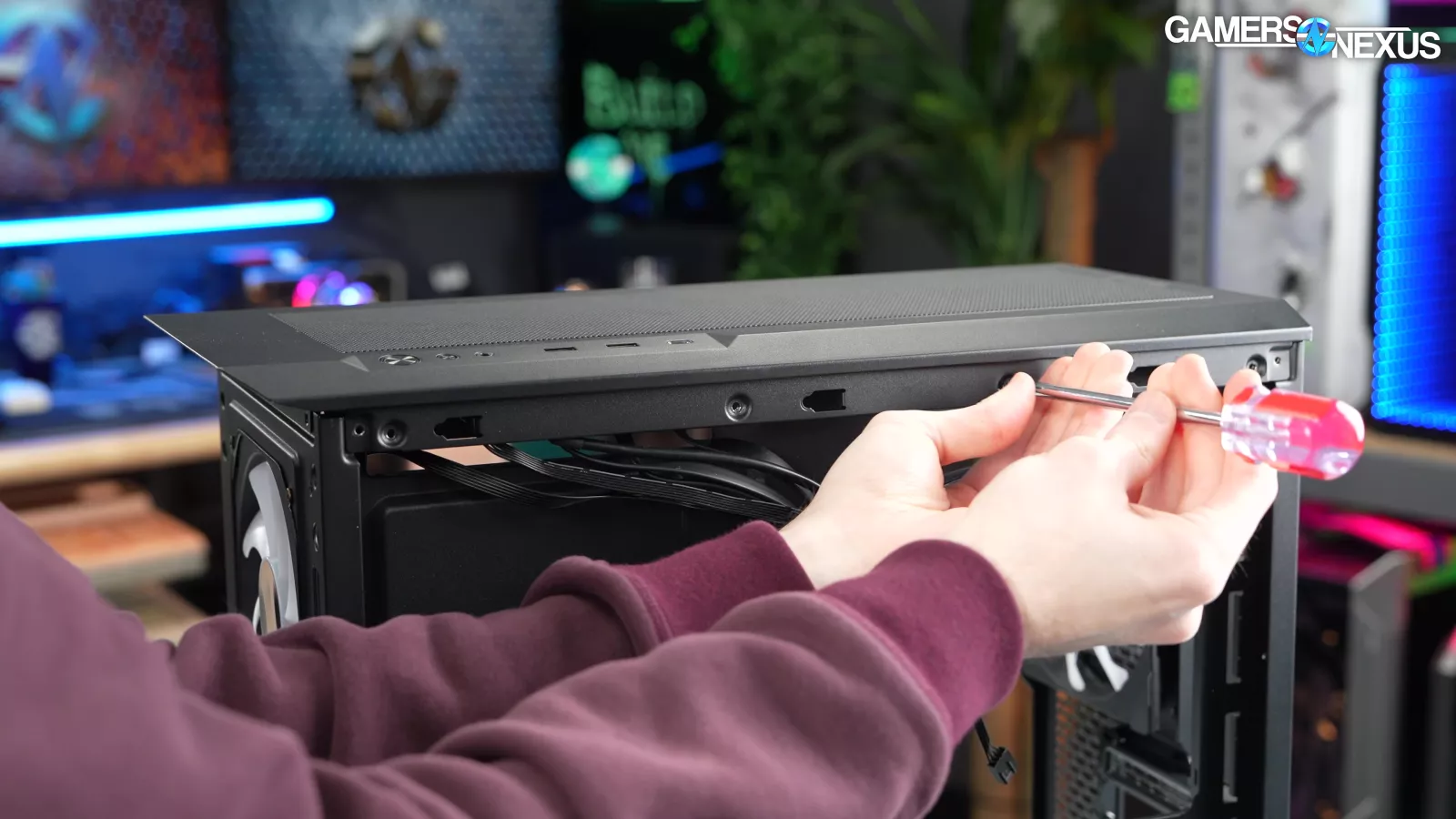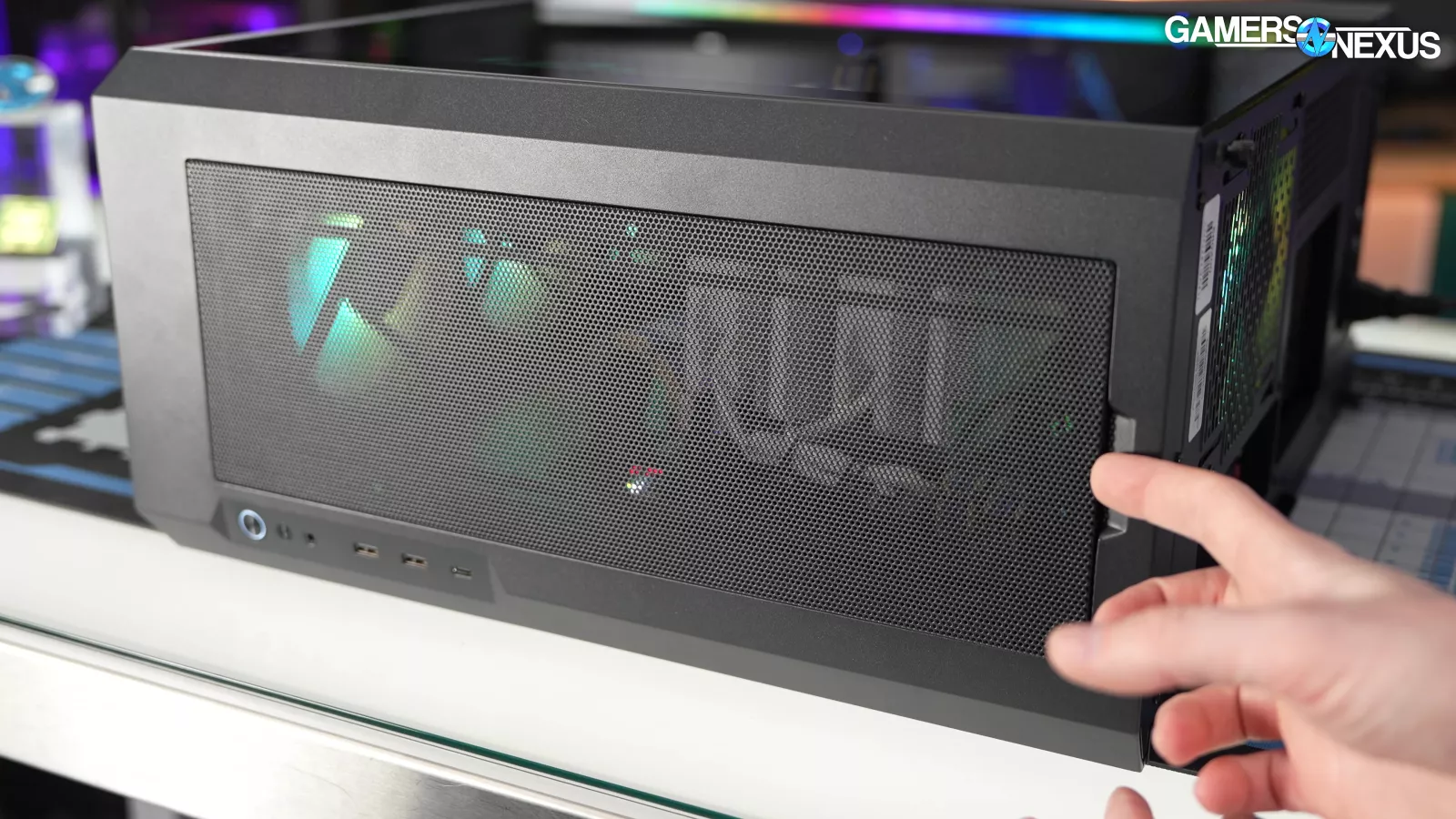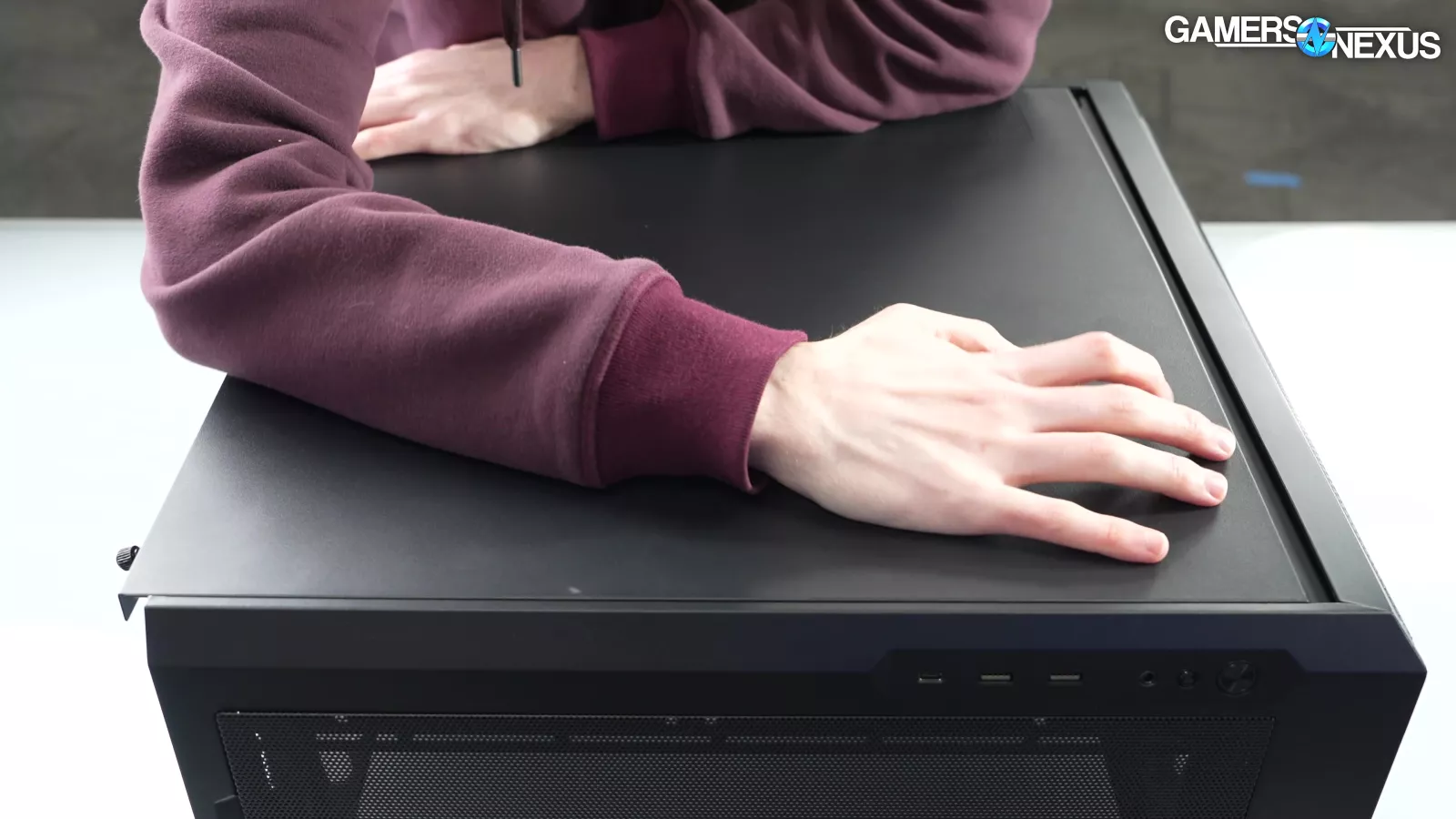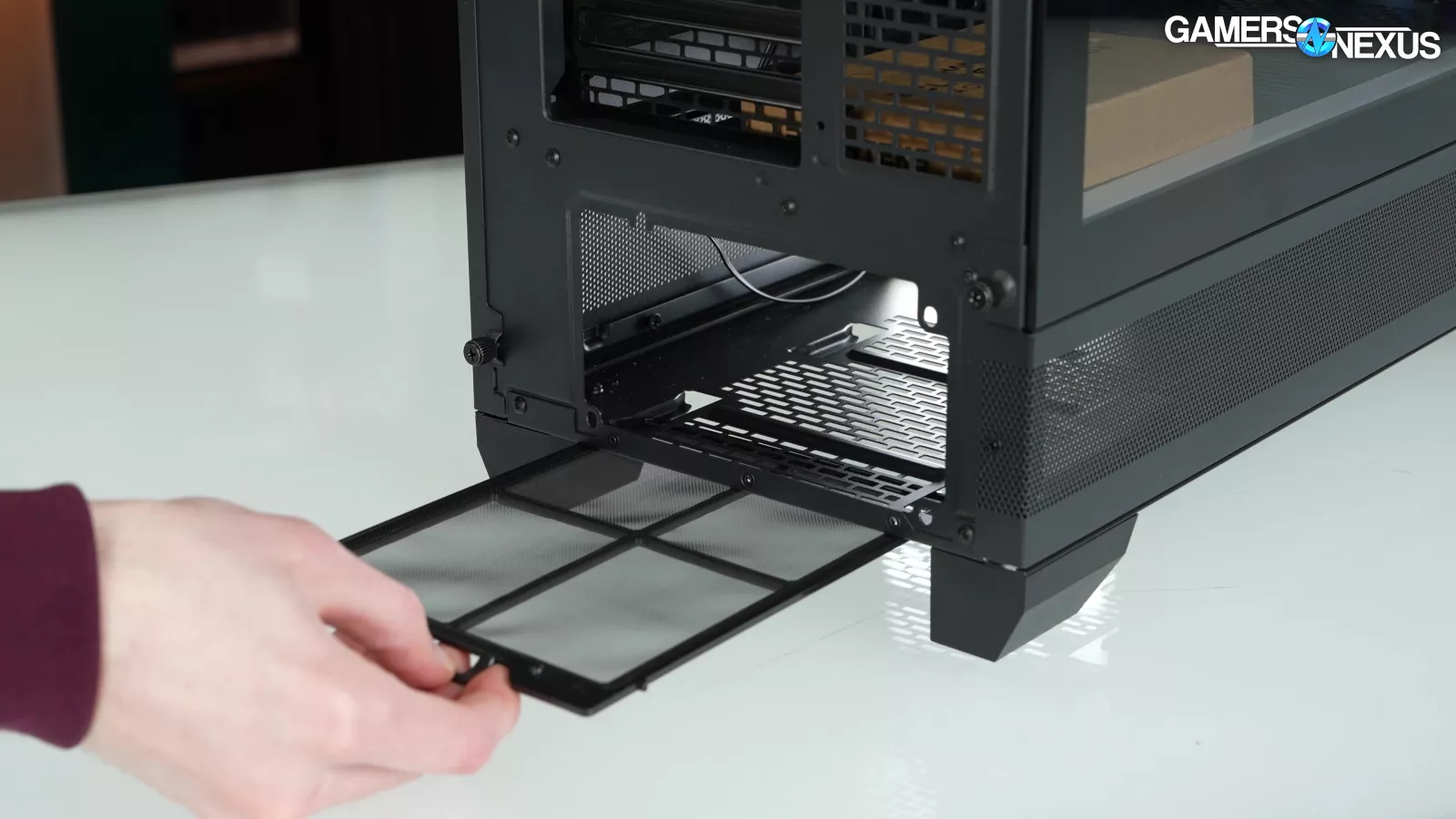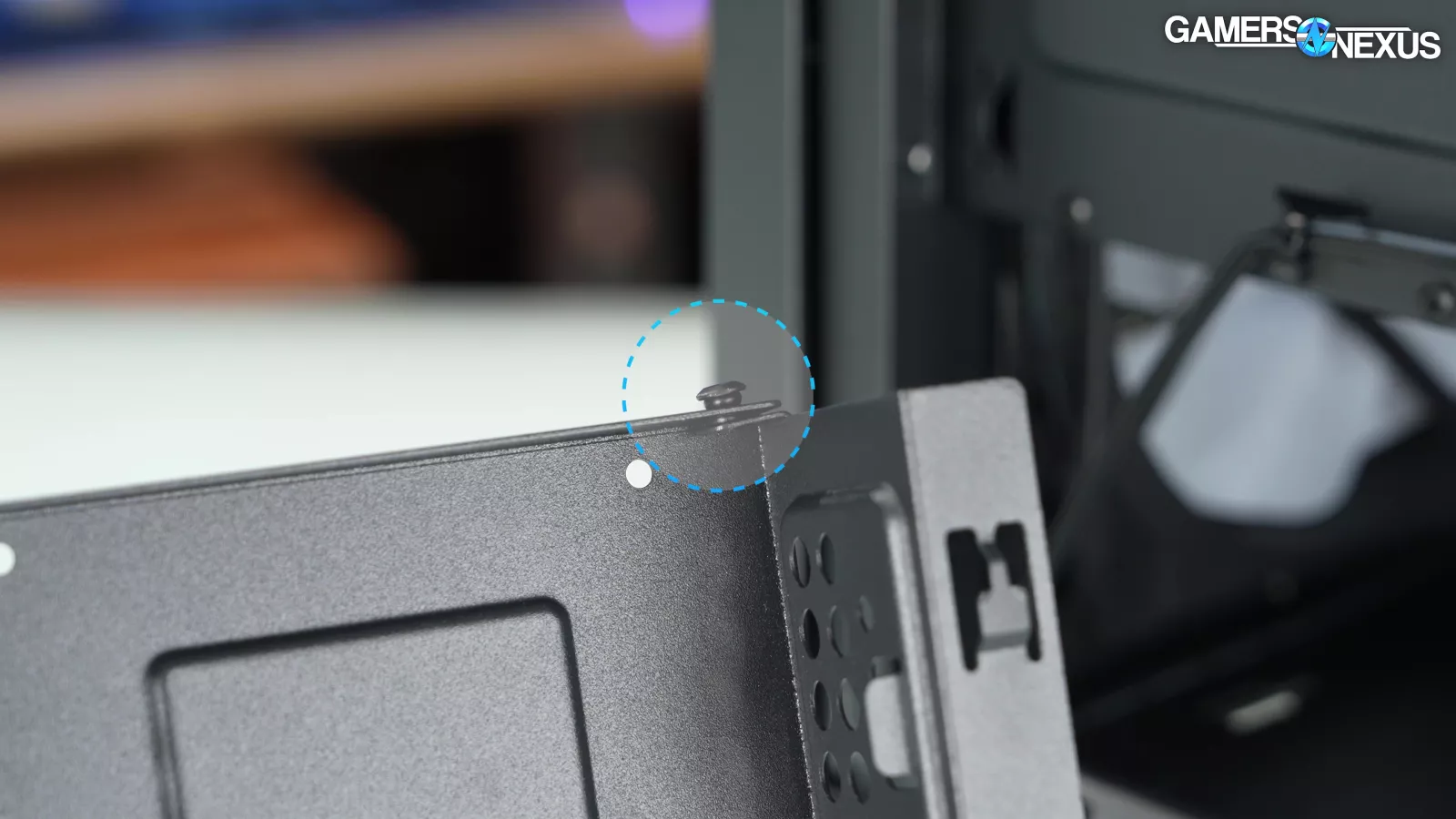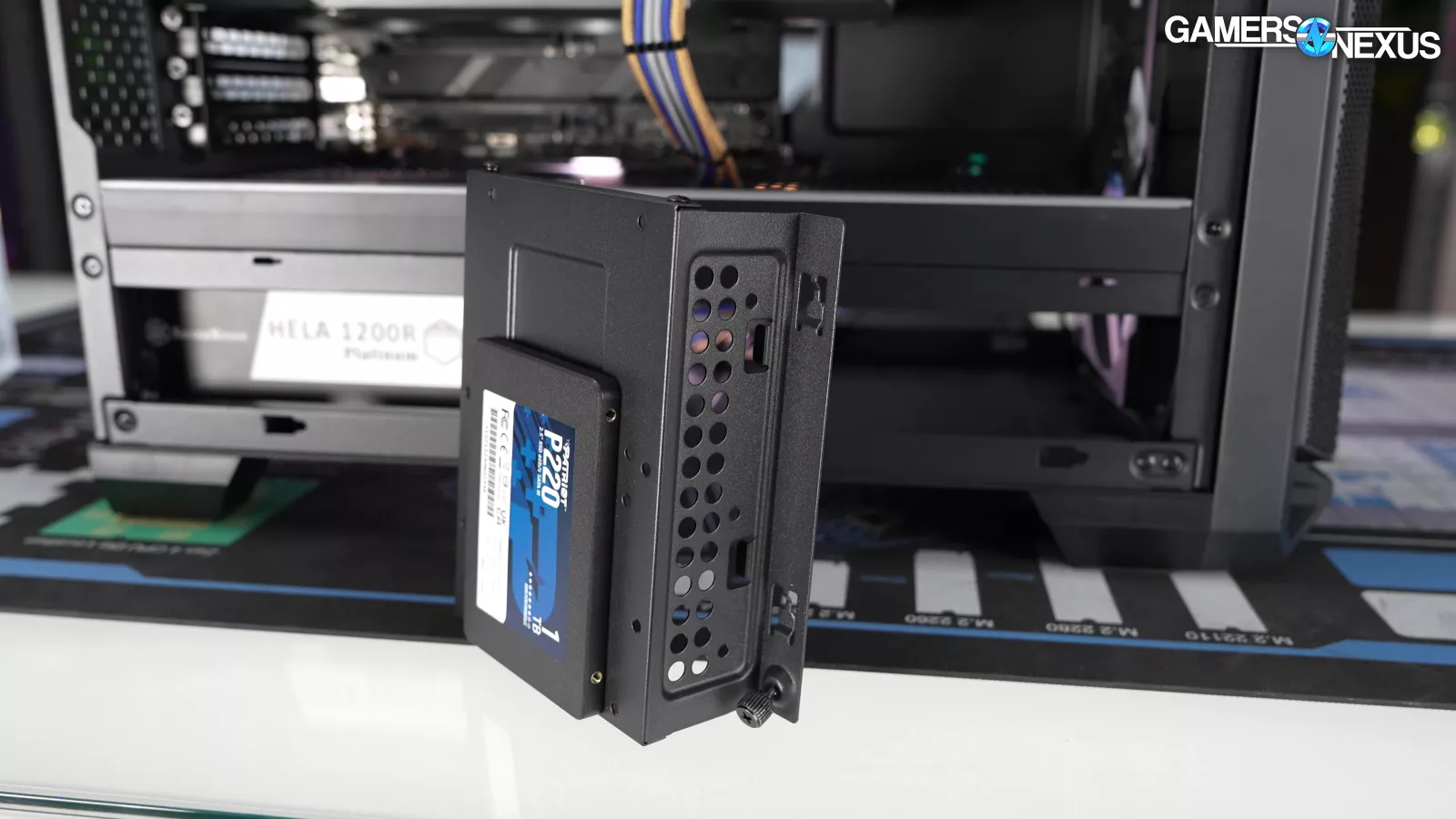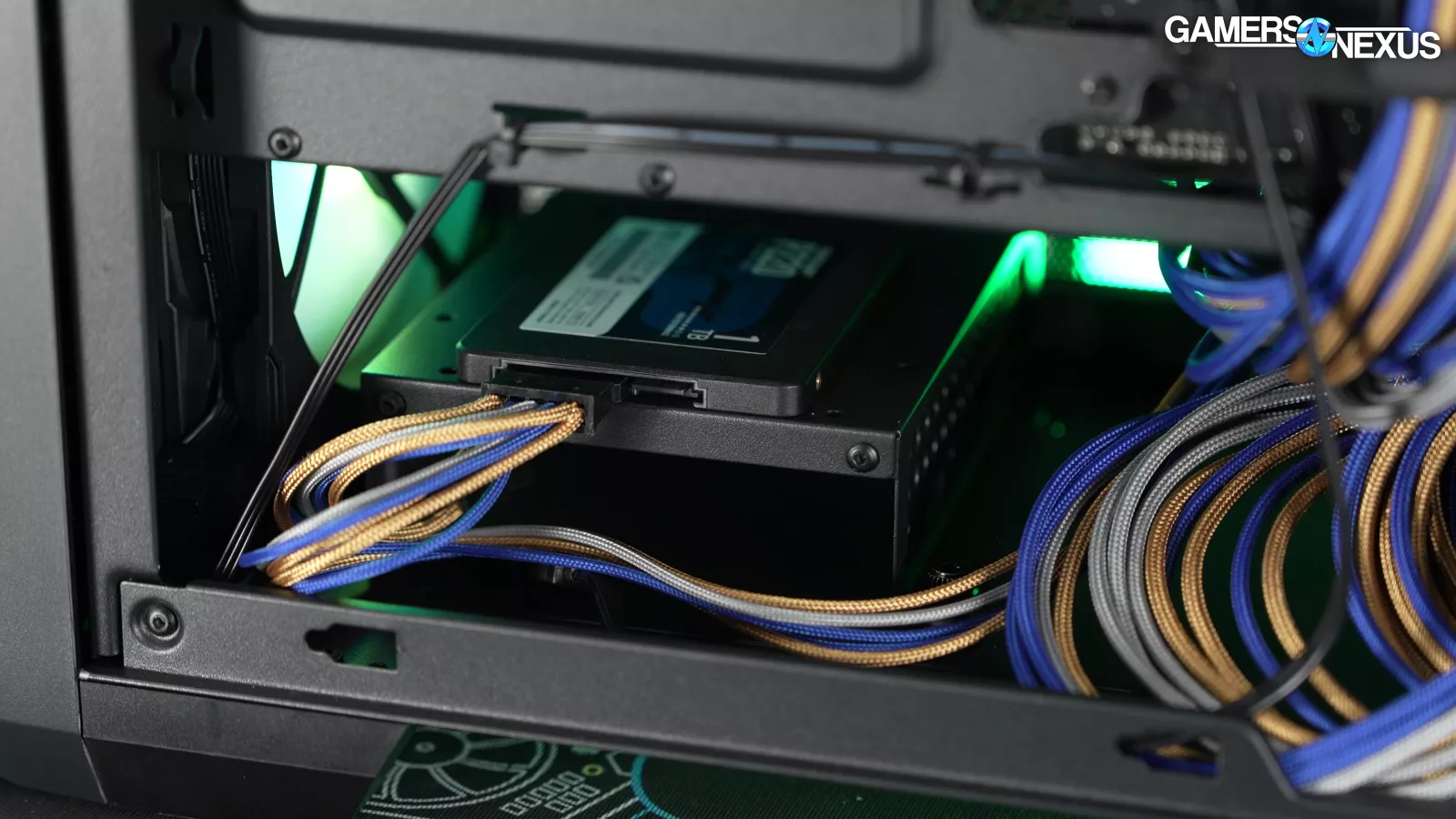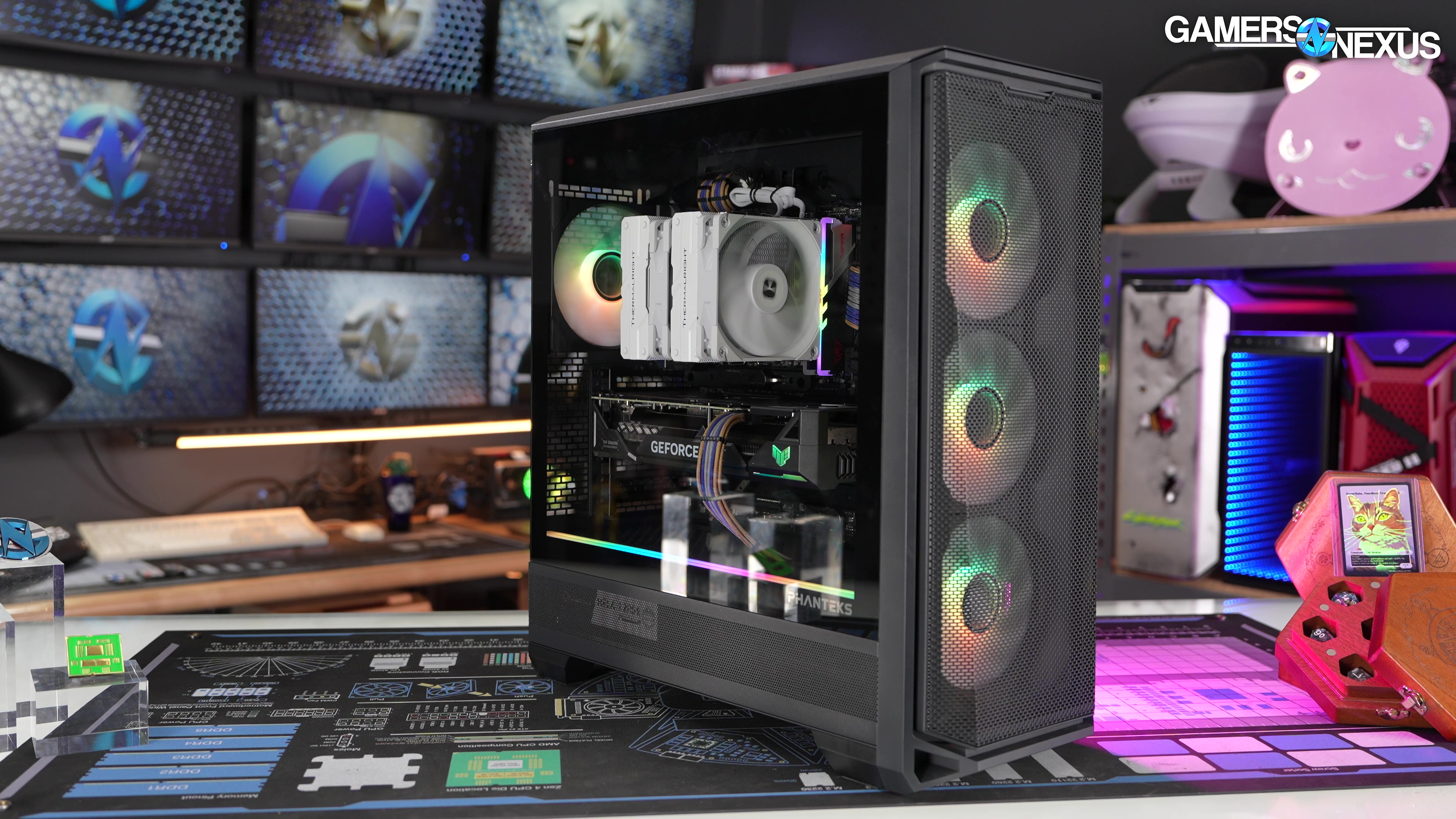
We analyze the Phanteks Eclipse G400A’s specs, build quality, thermals, and more
The Highlights
- The Phanteks Eclipse G400A uses wide-spacing mesh for the front panel coupled with a finer dust filter behind it
- The case’s biggest downside is that there's no official front radiator compatibility
- With 4 included 140mm fans, the G400A is a good case at a good price
- Original MSRP: $110
- Release Date: December 10, 2024
Table of Contents
- AutoTOC

Intro
Today we’re reviewing the Phanteks Eclipse G400A. It’s $110 and includes 4x 140mm fans that are met with a swooping inlet to try and prevent recirculation and funnel the air clean into the case. Phanteks is using wide-spacing mesh for the front panel with a finer dust filter behind it, doubling-up on mesh in a way that can hurt performance; however, there’s a lot of space between the filter and the front panel, which helps avoid issues introduced by pressure drop.
The front mount only officially supports 140mm fans. It helps that these are included, and while this does limit front mount support for radiators, forcing a specific fan can help performance. We saw Lian Li do this with its new Lian Li Lancool 207. Eliminating support for 120mm fans means reducing the amount of metal and railing obstructing intake of a 140, so this should be the ideal approach for cooling.
Editor's note: This was originally published on January 22, 2025 as a video. This content has been adapted to written format for this article and is unchanged from the original publication.
Credits
Test Lead, Host, Writing
Steve Burke
Testing
Patrick Lathan
Camera, Video Editing
Vitalii Makhnovets
Camera, Video Editing
Tim Phetdara
Writing, Web Editing
Jimmy Thang
The case is also elevated a lot, which will help with bottom intake (like for the PSU). That ground clearance is important. The lower side panel is a ventilated strip that’s intended to feed PSU shroud-top fans, although the porosity is relatively low.
Overall, Phanteks is aiming to compete in the airflow and performance market with this case.
Phanteks Eclipse G400A Specs
| Model No. | PH-EC400GA_DBK01 |
| UPC Code | 886523303558 |
| Case Dimensions | 495 x 230 x 522 mm | 19.5 x 9.05 x 20.55 in |
| Form Factor | Mid-tower |
| Mainboard Support | *E-ATX | ATX | Micro-ATX | Mini-ITX *Up to 280 mm wide |
| Materials | Steel chassis | Tempered glass |
| Side Window | Yes |
| PCI Slots | 7 |
| Vertical GPU Support | 3-slots Riser Cable sold separately |
| Internal 2.5″ Bay | 2 + 1x 3.5″ HDD |
| Internal 3.5″ Bay | 2 + 0x 2.5″ SSD |
| Front I/O | 1x USB 3.0 1x USB-C 3.0 Gen2 Microphone | Headphone Combo Reset button Power button + LED |
| Fans 120 | 140 | Total Fans: 7x | 6x Top: 3x | 2x Front: – | 3x (3x 140 Pre-Installed) Side: – | – Rear: 1x | 1x (1x 140 Pre-Installed) Bottom: 3x | – |
| Radiators 120 | 140 | Top: Max. 360 | 280 Front: – | – Rear: 120 | – Bottom: – | – |
| CPU Cooler Height | 184 mm | 7.24 in |
| GPU Length | 415 mm | 16.33 in |
| GPU Width | 184 mm | 7.24 in |
| Power Supply Length | 270 mm | 10.60 in |
| Top Radiator Length x Width x Height | 360 Radiator: 415 x 138 x 60 mm | 16.33 x 5.43 x 2.36 in 280 Radiator: 360 x 147 x 65 mm | 14.17 x 5.78 x 2.55 in |
| Rear Radiator Length x Width | 170 x 132 mm | 6.69 x 5.19 in |
| Net Weight | 8.63 kg | 19.02 lbs |
| Gross Weight | 10.50 kg | 23.14 lbs |
| Warranty | 5 Years limited |
| Scope of Delivery | 1x Eclipse G400A chassis 4x M25G2-140 fans (Pre-installed) 1x D-RGB mainboard adapter |
| Accessory Box | 30x Zip ties 4x Screw cover corner L 4x Screw cover corner R 4x Screw cover bridge |
| Screws | 18x Mainboard | SSD screws 4x Power supply screws 8x HDD screws 12x 30 mm fan screws 1x Mainboard stand-off 1x Stand-off removal tool 1x Extra R-side panel screw |
Specs copied from manufacturer materials, please read review for our own measurements and opinions
Overview
The Phanteks Eclipse G400A has been a long time coming. Back in early 2016 we were initially unimpressed by the Phanteks Eclipse P400 (watch our review) with the solid panel, but we had a more positive opinion of the airflow-focused P400A (D-RGB) in 2019 (watch our review). With a launch MSRP of $90 and three stock fans behind a simple mesh front panel, the P400A remained a strong competitor in price-to-performance for years after its launch. Over those years, Phanteks has incrementally updated other Eclipse cases from P to G versions, but it's held off on the most important model for so long that some of the updated G cases are now end-of-life. Finally, though, the G400A is here, and we can see whether it's a worthy successor at $110.
Key competition to the G400A includes the Lian Li Lancool 207 that we reviewed recently, which takes on a similar approach to design and can currently be bought for around $80. There’s also the new Corsair FRAME 4000D, which we have in for testing already and are working on. We’ll cover the other competition as we work through this review.
The Build
Getting into the build quality and assembly notes first:
The G400A's front panel diverges from the formula that made its predecessor so successful: the P400A just had a sheet of mesh with no additional filtration, while the G400A uses "brick pattern" mesh (with larger rectangular holes) backed by a filter.
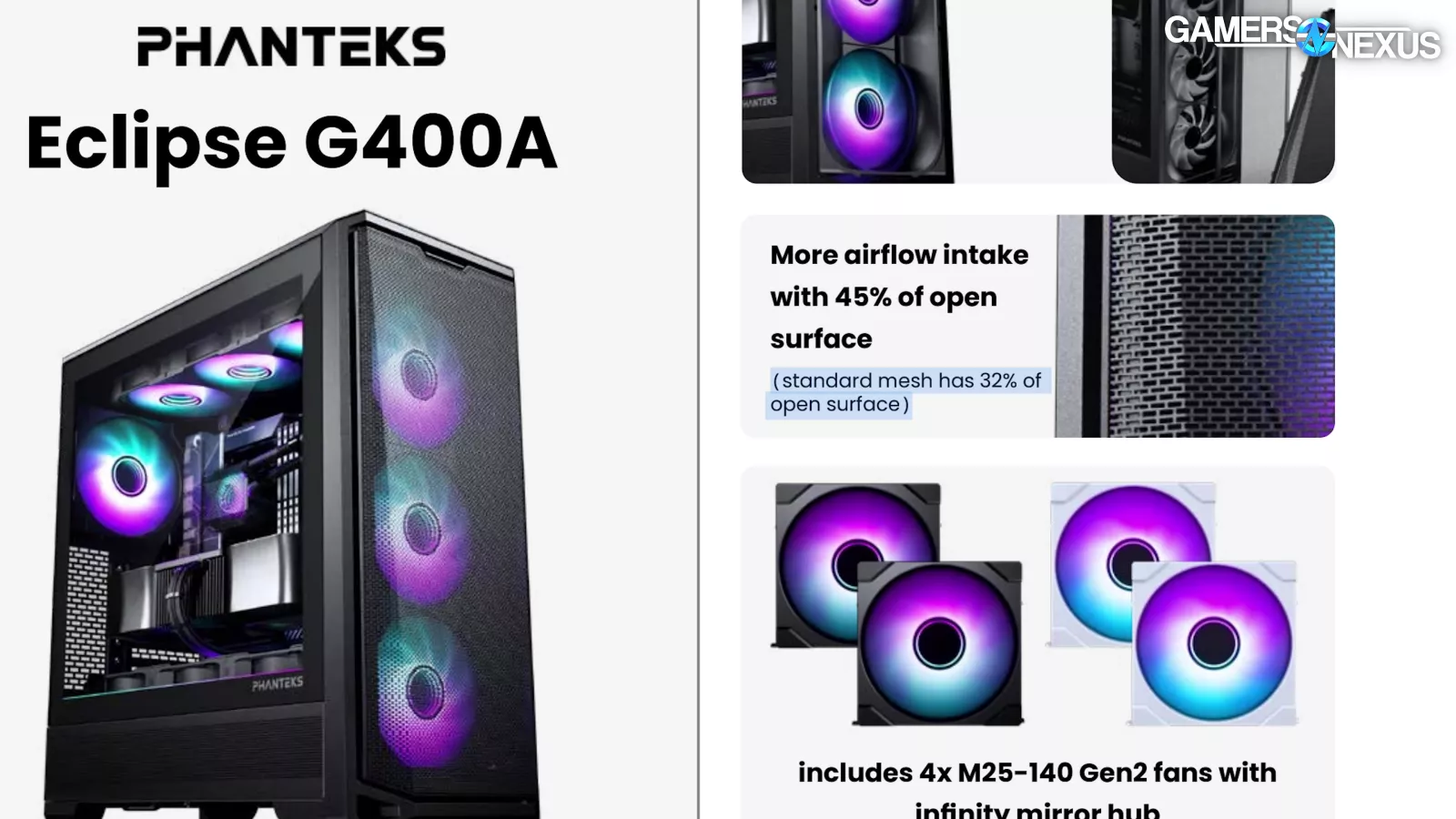
Phanteks advertises that the mesh is now 45% open surface, versus 32% for what Phanteks calls "standard mesh." We’re not sure exactly what “standard” means.
Both the mesh and filter are magnetic, and the filter can be removed without altering the appearance of the case; we'll test that later on. The filter has plenty of clearance (>2cm away from the intake fans), but it's one of the saggiest we've ever seen. On the plus side, the lack of reinforcement means that nothing blocks the LED lighting and nothing blocks the intake.
Phanteks has also revealed a G400N variant with two tempered glass panels and more elaborate cable management, but that version hasn't yet been released.
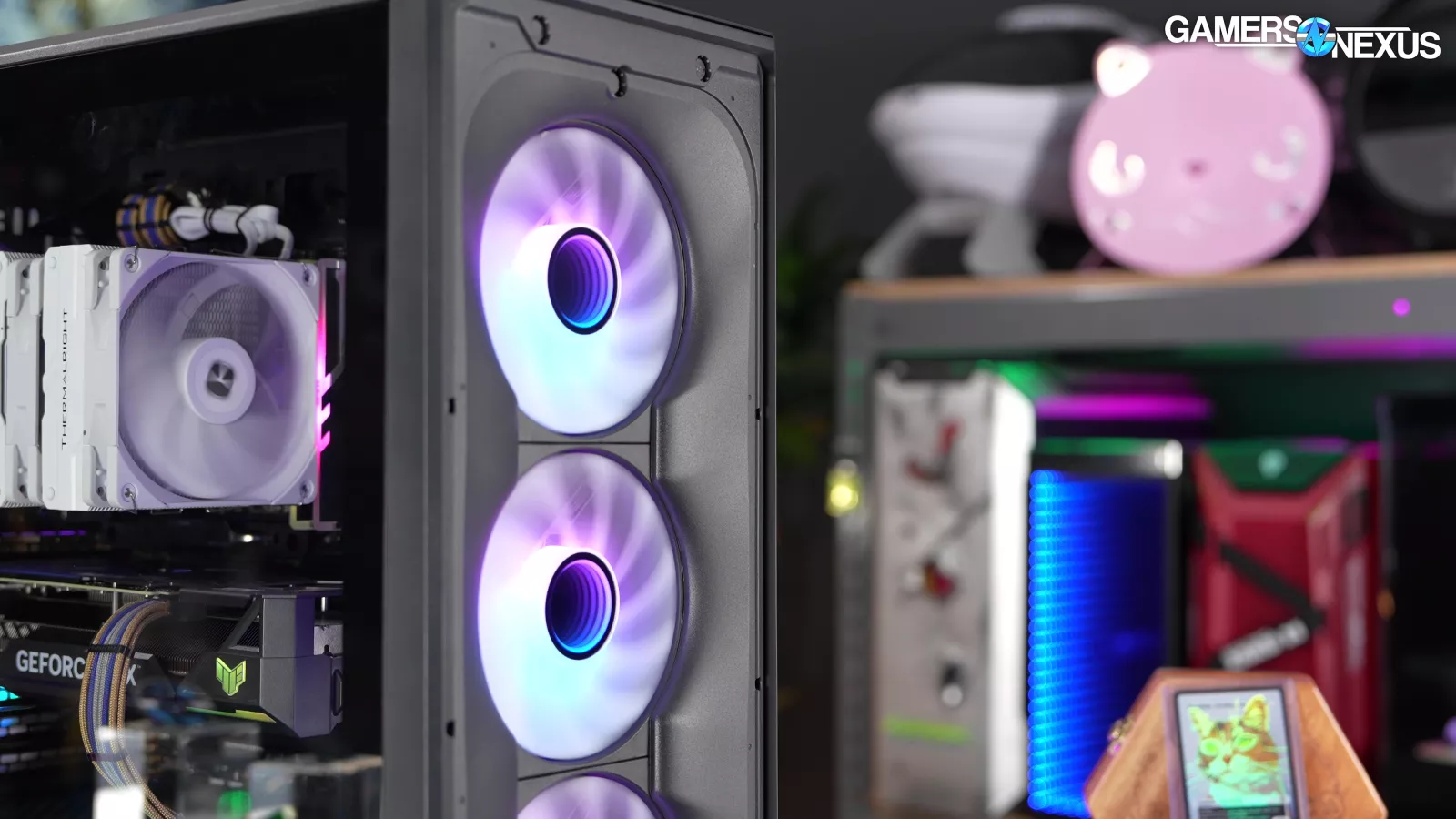
The front panel includes a plastic frame that's shaped around the 3x 140mm ARGB infinity mirror fans. The choice to only support 140s in the front is in contrast to the P400A, which had more front mounting options, as well as a cheaper non-Digital variant for customers who wanted to use their own fans.
The uniquely-shaped plastic frame might help to keep air from recirculating through the front fans, but the fans are already sealed against the metal chassis.
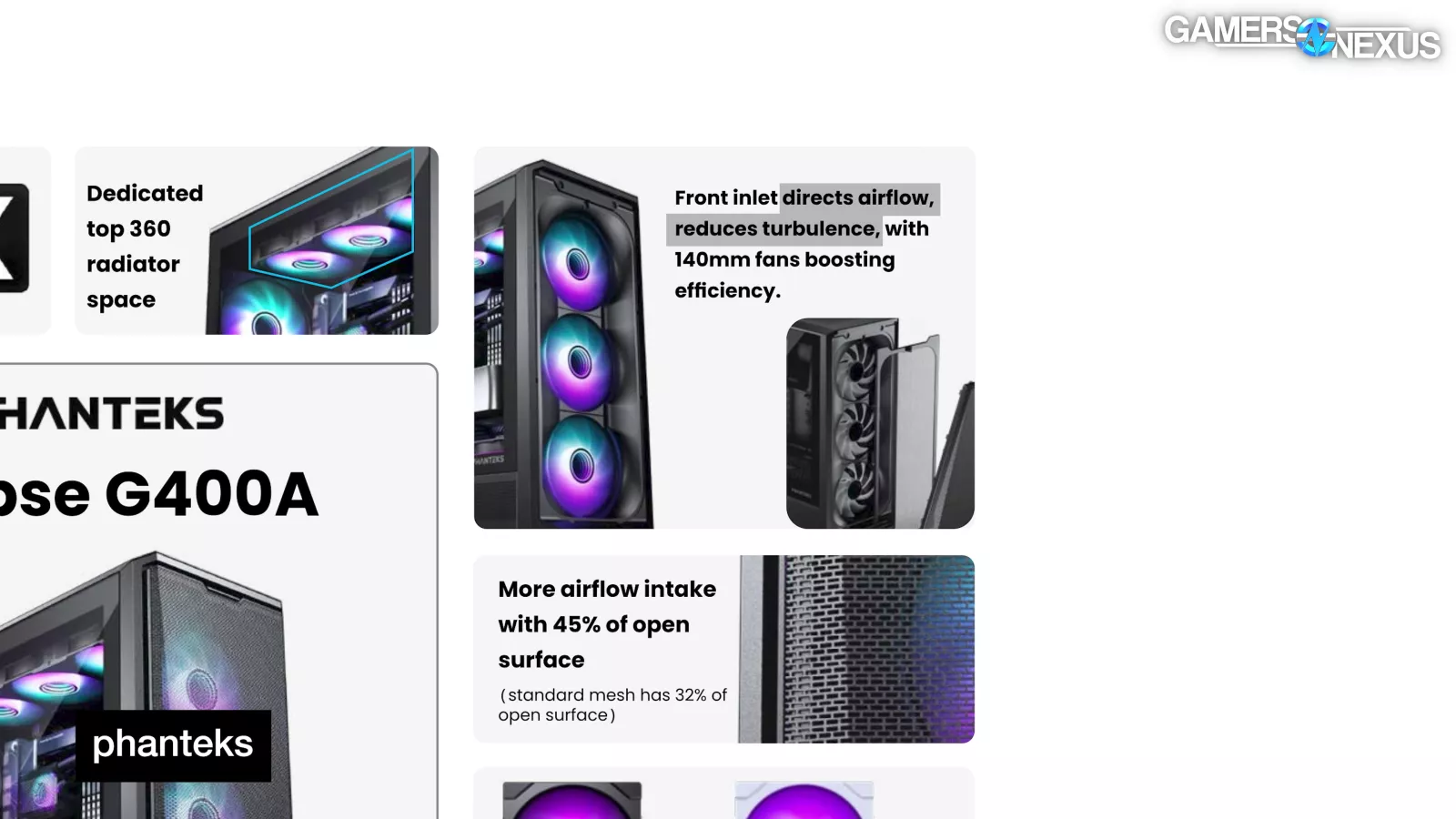
According to Phanteks it "directs airflow [and] reduces turbulence."
The front fans are uniquely joined into a single unit, which could be useful in some contexts. In the G400A, there unfortunately isn't enough room to easily take all three fans out in one piece while a system is inside the case. In situations where that’s not possible, the remaining benefit of the uni-fan approach is that the front fans are daisy-chained together, sharing a single ARGB and fan header. All of the fans have Phanteks "LINK6" connectors and need adapters to connect to standard fan and ARGB headers, which may limit how reusable they are for future builds.
The G400A's focus on shroud ventilation with a two-part glass and mesh side panel is similar to some Antec and Lian Li cases we've covered, but in particular, the Lancool 207. The 207 also has infinity mirror fans and a similar magnetic front panel, but we saw both the 207 and the G400A at Computex, so they were likely in development in isolation and at the same time.
The G400A has 3x 120mm mounting locations atop the shroud, but at least one of these is of limited usefulness due to the presence of the rear-mounted PSU. The biggest difference with the 207 is that it moves the PSU forward to make way for cooling with clear outside access directly into the GPU.
The 207 led two categories in our Best PC Cases for 2024 roundup, and it's a tough act to follow with a steady price of $80 on Amazon. The G400A differentiates itself through its larger size and more conventional layout, which gives it an advantage over the 207 in cable management (our biggest complaint with the 207). The suggested routing from Phanteks' manual worked well even with our large sleeved cables, although we opted to route the GPU through the shroud. If you install fans on top of the shroud, that's not an option. The removable section of the top panel and roomy upper area makes working with EPS12V cables for the CPU and other connectors at the top of the motherboard easy. The G400A also supports motherboards with rear-mount connectors; Phanteks specifically mentions BTF and Project Zero boards as compatible.
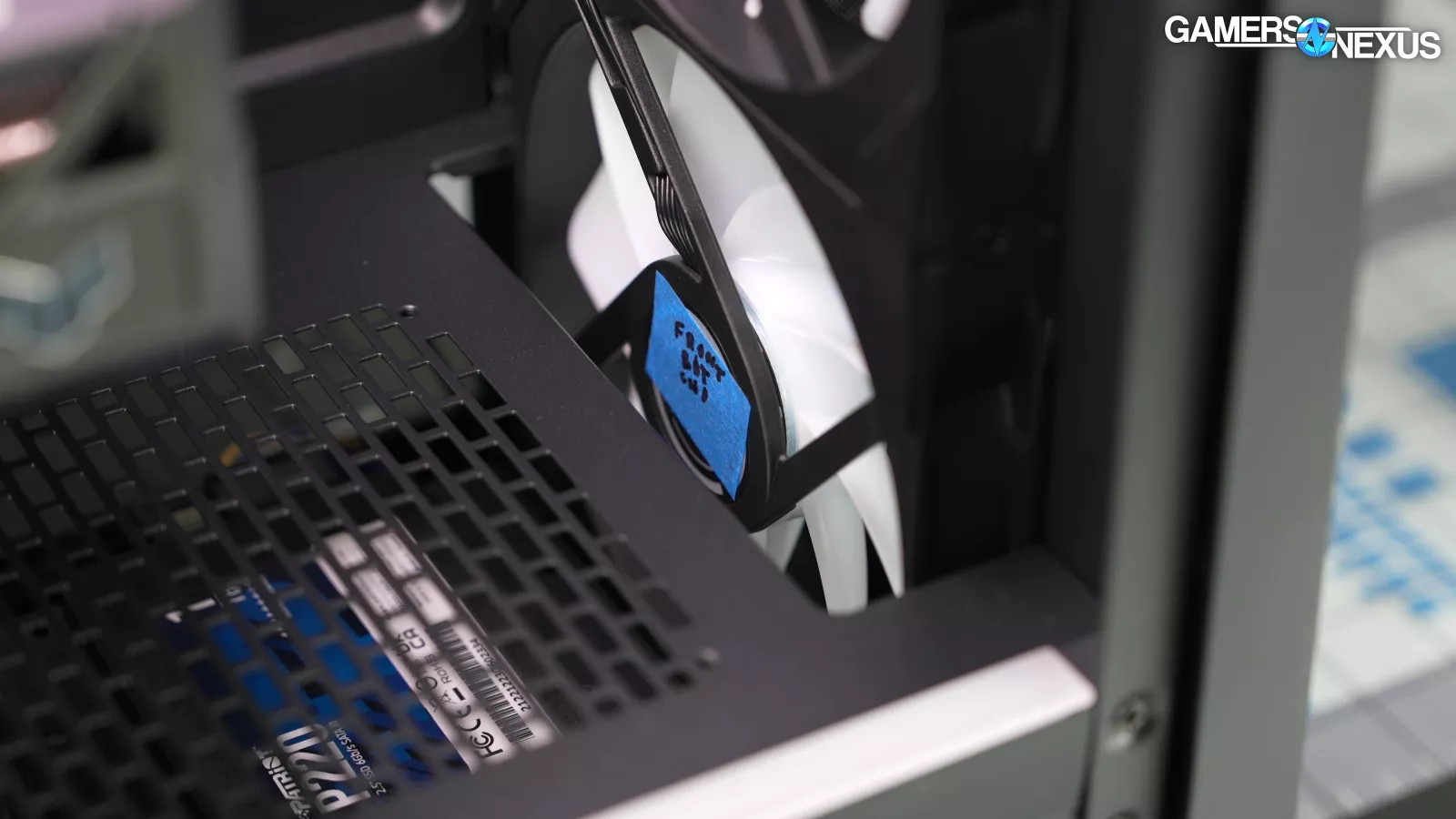
Surprisingly, the G400A doesn't have better radiator support in any meaningful way than the 207. The shroud cutout at the front of the G400A doesn't leave room for radiators, and although it might technically be possible to force a 280mm rad in, it's not officially supported. Headroom at the top of the case is excellent with more than 7cm of clearance from the top edge of the motherboard to the roof, and the removable top mesh panel makes the top fan mount easy to access for installing radiators up to 360mm.
The whole top of the case is also technically removable, although doing so requires removing 15 screws. Even though it’s kind of a pain to remove, we like the additional access without losing rigidity of the overall frame. This optional feature can help with maintenance and installation.
But as far as radiators, we don't generally recommend trying to fit 360mm open-loop radiators in the case (as opposed to a CLC) since the fittings will come close to the stock fans. It’s doable, but will require more effort than typical for custom loops.
There are some minor quality-of-life issues that aren't unusual for cases in this price range:
The top mesh section is a little stiff and difficult to grab, the steel side panel has to be pressed down on all sides to slide into place and could be executed better. The PSU filter unfortunately ejects from the rear of the case, meaning that pulling it away from a wall will be necessary in most situations. The only construction problem was an improperly installed rivet inside the drive cage, but the cage still worked fine.
Drive support is adequate but bare-bones, limited to either 2x 3.5" drives or 2x 2.5" drives and 1x 3.5" drive. There's no built-in vibration damping, and Phanteks didn't bother cutting extra slots for moving the cage to any alternate locations.
Phanteks Eclipse G400A Thermal Benchmarks
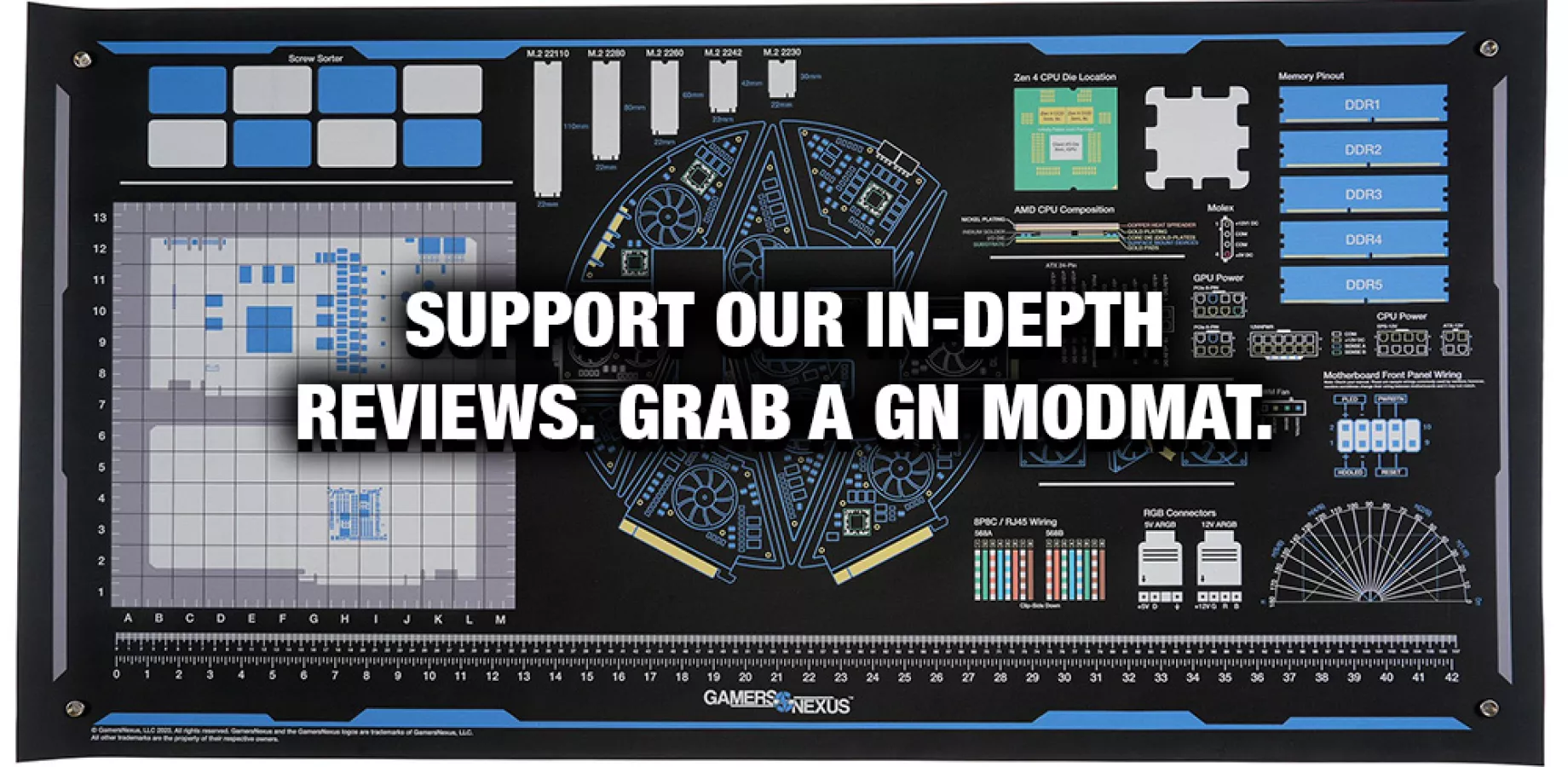
As well as running our usual suite of tests on the G400A, we went back and ran the P400A, as well as the G400A without its front filter in order to match the older case. The obvious competitor to watch in these charts is the significantly cheaper Lancool 207, but the NZXT H5 Flow 2024 is a close match to the G400A in both price and layout. Antec's Flux (non-Pro) with five stock fans is similar as well at $120, although we haven't tested that model. Let’s get into the benchmarks.
GPU Full Load Thermals - Noise-Normalized

The first test is for noise-normalized thermals on the GPU.
With the four stock case fans slowed to hit our noise-normalized target of 27 dBA SPL, the G400A made a good start with an average GPU temperature of 45 degrees Celsius above ambient compared to the P400A's average of 49 degrees. That's near the middle of our chart, but many of the cases above it required aftermarket fans (HAVN HS420, O11D EVO side intake) or are from a higher price tier. The most relevant exception is the Lancool 207, which averaged 42 degrees above ambient in this test with its direct GPU cooling. The Lancool 207 was built for this and shows advantages in cooling. The Antec C8 (read our review) also does well here, though is a larger dual-chamber style.
The G400A isn’t exceptional, but is average to above average for GPU cooling.
CPU Full Load Thermals - Noise-Normalized

Moving to CPU thermals in the same noise normalized test, the G400A again outperformed its predecessor at 41 degrees above ambient for the average all-core temperature and 45 on the P-cores versus 46 all-core and 50 P-core on the P400A. It's encouraging to see that one of the better-cooled cases we'd reviewed as of late 2019 has been outperformed by a decent selection of new cases. The G400A effectively tied the 207 here (as well as the more expensive Antec Flux Pro) without a solid lead in either all-core or P-core averages. Both cases are good here.
CPU Full Load Thermals - Full Speed

The G400A is quiet for the level of CPU cooling that it provides at 100% fan speed, with an all-core average of 39 degrees above ambient at 37 dBA while some similarly-performing cases like the Torrent (watch our review) and North XL (read our review) are significantly louder. That includes the 41.6 dBA Lancool 207, which still tops the chart but is less than two degrees ahead of the G400A, yet is noticeably louder.
Removing the front filter had barely any effect on thermal performance, so we recommend leaving it in place unless the sagging causes problems.
GPU Full Load Thermals - Full Speed

Taking a quick glance at the GPU thermals under full load and at max fan speeds, we can see that removing the filter also had minimal effect here. As long as it's kept clean, leaving this filter installed shouldn't hurt.
GPU Full Load Thermals - Standardized Fans

Our standardized fan test uses the same set of three fans in every case, which is useful here for comparing the ventilation of the P400A and G400A while removing stock fans as a variable. The G400A shows definite improvement, with an average GPU temperature of 49 degrees above ambient versus 52 degrees on the original P400A.
Neither of the Phanteks cases perform well versus the rest of this chart, but you should plan to keep the G400A's stock fans, so its performance without those stock fans isn't particularly relevant.
CPU Full Load Thermals - Standardized Fans

In the same standardized fan test, CPU thermals improved from 41 degrees above ambient all-core in the P400A down to 38 degrees for the G400A. It seems like Phanteks has managed to improve cooling not just through brute force, but also through panel design, while not sacrificing dust filtration.
VRM & RAM Full Load Thermals - Noise-Normalized

Circling back to the original noise normalized results, the G400A had excellent VRM thermals at 28 degrees above ambient, near both the Lancool 207 and Flux Pro (read our review) at 27 degrees. Memory temperatures were similarly good. This may be due to the G400A's high ceiling in combination with the four 140mm fans that provide airflow up to the very top of the case.
Phanteks Eclipse G400A Conclusion

In comparison to the older P400A, the G400A is a solid improvement in thermal performance and it keeps most of the feel and stylings of a Phanteks case. In our original review, we concluded that "given a choice we much prefer a single layer of perforated metal to a decorative mesh panel backed by a foam or fabric filter." That's still generally true, but Phanteks deserves credit for building a case with a filter that doesn't significantly hinder airflow.
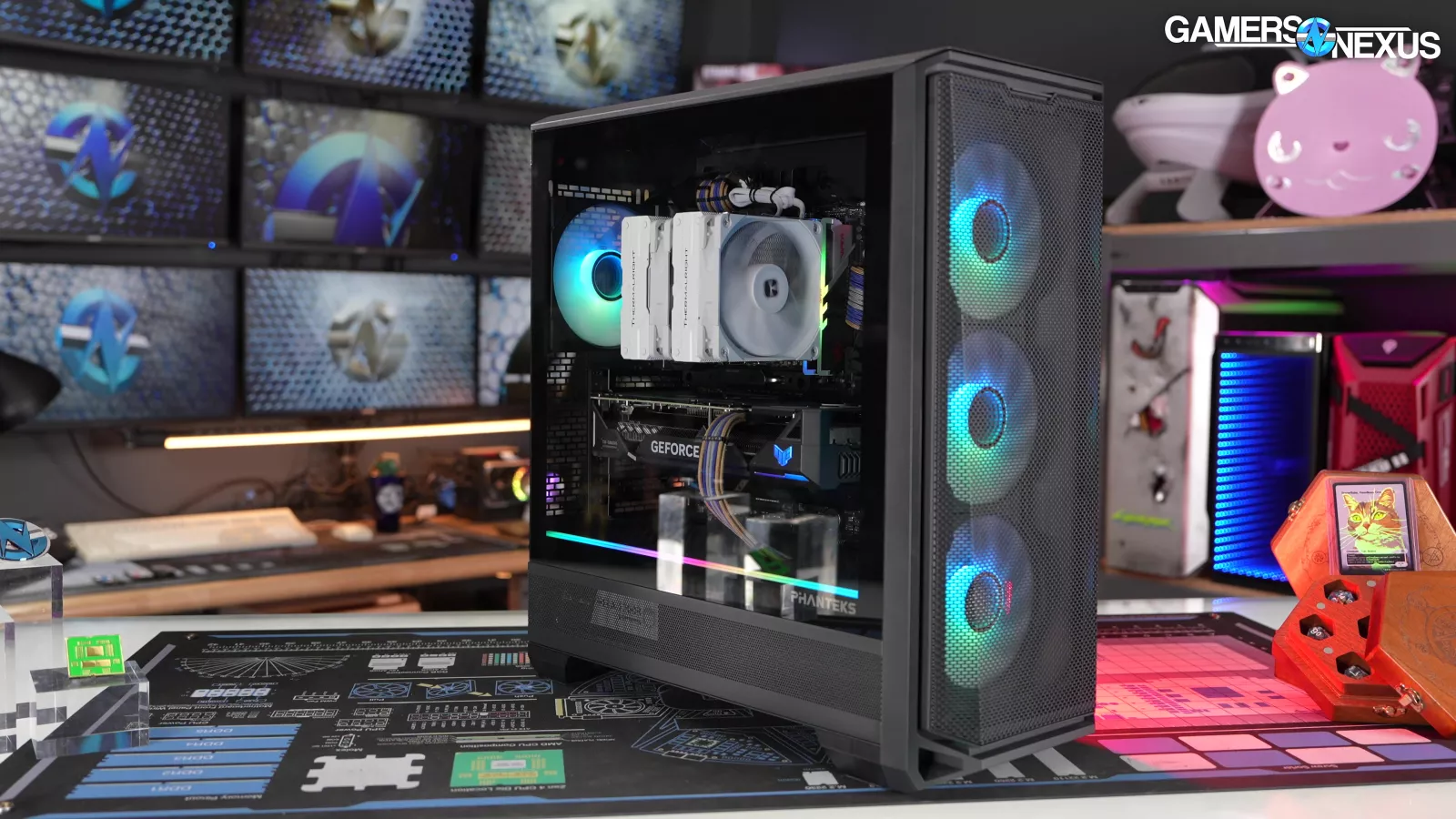
The G400A is a good case at a good price, but it's hard for anyone to compete against the Lancool 207. Phanteks' advantage is that the G400A is a bit larger, and therefore it fits slightly larger components. It definitely has more cable space than the 207, for example, with cable management really being our only big complaint with the 207.
Phanteks committed fully to the stock fans that it includes with the G400A, which we agree with for the most part. The biggest downside is that there's no front radiator compatibility, although it might be possible to get a 280mm rad installed.
At $110 with the 4 included 140mm fans, the case is overall competitive. It’s pretty good in terms of ease of installation. The removable top is nice, though it is a bit of a pain to remove it.
If you like the G400A and just wanted to read a review to look for any problems, we’d say go for it. Just keep in mind any size limitations as it’s a little smaller for an ATX case. But if it’s within your budget and you like it more than the Lian Li Lancool 207, we think the G400A is a well-executed Phanteks case. It’s good to see that the company is back in a good way.
